#ill get character details later
Text

i was bored so i made a new "fur"sona. A moth heavily inspired by the species Dinumma Deponens! Her name is Dinum :)
#wynns art#my art#fursona#furry#anthro#moth#mothsona#bugsona#anthro bug#ill get character details later#i uh#tried a new style of choosing shading colours that i learned from tumblr user gillbuoy#shifting the hue of the colour im shading over until it looks good#i think it looks good#dinum (oc)
98 notes
·
View notes
Note
I was watching season 3 episode 2. And an interesting detail is that when Sonic went to save a falling citizen, Nine initially looked scared and concerned for their safety when it was revealed that they were in danger. However Nine’s fear is then replaced with anger and it’s then shown Sonic saved them.
It’s really interesting seeing Nine’s descent into his insanity. At the beginning, His villainy is SOLELY towards Sonic but as more time passes, he becomes crazier.
YEA!!! But like, his thing is that he doesn't want to hurt anyone. He never did, just defend himself against those that try to hurt him first.
He went after Sonic so incessantly because he needed his energy to stabilize the Grim (and also because he was angry at him) and have his own little paradise where he would be left alone
Buuut then he began getting just a bit silly with power and the fact Sonic seemingly only kept pulling his leg and backstab and trick and betray him over and over again that he lost his own plot
All he needed was for Sonic to understand and genuinely get what he had in mind and bring him back to earth and he went all mournful sad little wide eyed wet cat
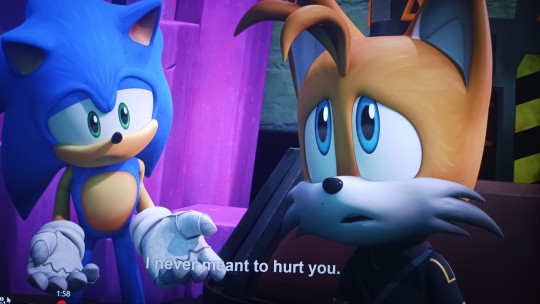
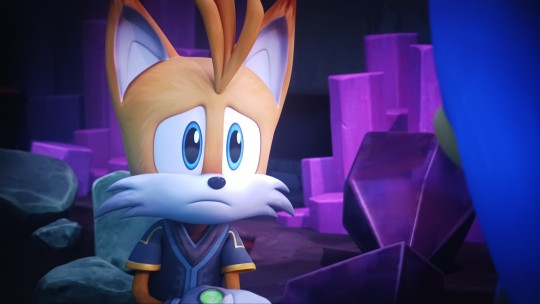

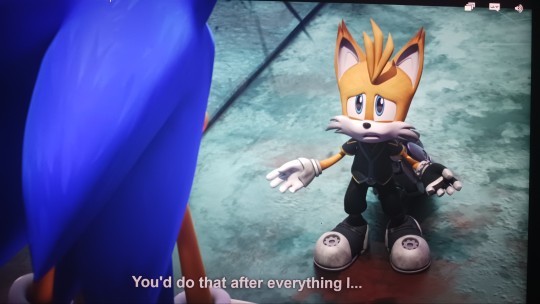
LOOK AT THIS LITTLE GUY AND TELL ME HE WOULD EVER GENUINELY HURT ANYONE ON PURPOSE AND NOT REGRET IT FIVE MINUTES LATEr
GOING ABSOLUTELY REGUAL NORMAL PERSON MODE WHEN THINKING ABOUT THE COMPLEXITIES OF THIS FUCKER JUST THE MOST CASSUAL
#sonic prime#sick and ill over this guy alll over again#my beloved#there were some shortcomings for this season yes#SUCH AS MANGEY AND SAILS BEING DEAD FOR THREE OR MORE EPISODES!!!#but. but. they handled Nine so well#OOGshsgshs#i will get to ramble about his animation and character details later#I was going FERAL when watching him switch from a deranged orange stickbug to a menacing 8 y/o and than a sad wet cat#miles nine prower#nine the fox#sonic the hedgehog#sonic prime spoilers#sonic prime season 3#the silly ask box
64 notes
·
View notes
Text
Is this a safe place to admit I don’t really like the way Castiel is often talked about in relation to destiel or will I be crucified for the second time
#listen okay#I get it I get it destiel website#but#I really hate the way Dean is often used as the ONLY bit of free will Cas has#and that Cas ’belongs’ to Dean#I like can’t stand it#especially when Sam is often used as the butt of the joke as being lesser to Dean#like Cas did rebel before Dean multiple times#he really WAS in love with humanity!!!#and making his character solely about Dean removes a lot of the things that make him interesting to me#this kinda goes hand in hand with the way Dean feels more…. centered in the later seasons??#ill probably make another post detailing this but#I don’t hate Dean or anything but there’s certain things I find very strange in later seasons is all#and by strange I mean I wanna put all the supernatural writers into a box and shake them around a lot#Castiel#spn
55 notes
·
View notes
Text
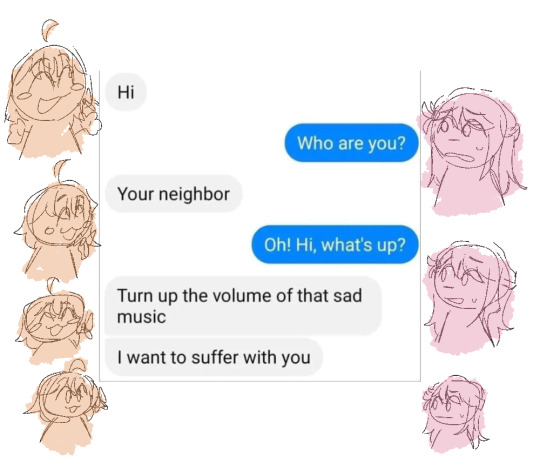
hi i just watched the 1st season of sunshine yesterday. does this mean anything
#technically i saw the yohane spin off first a couple days ago but. details#i like them :] aqours funny#i remember trying to watch sunshine before though like 6 years ago and not making it through the first couple of episodes#i thought it was kinda boring and i didnt really like the characters. i was wrong theyre great#ive yet to watch season 2 though but ill get to it later#maybe i shouldve watched the first love live though cause i think this ones technically a sequel?#idk i didnt know anything about love live a week ago#love live sunshine
16 notes
·
View notes
Text
the rock is so unnecessary
#the worst part is you cant even tell if bi-han pushed it on purpose or not#bc he just said earlier he doesnt really consider smoke his brother but no emphasis was on his possible ill-intent#so the rock falling and almost hitting smoke was an incident#BUT WHY INCLUDE IT THO. YEAH WE KNOW SMOKE IS IN DANGER. WHY HAVE BI-HAN ACCIDENTALY PUSH A ROCK THAT COULD KNOCK SMOKE OFF#im getting pissed off about details i hate it here. if only gngnggh those characters gnhnhnhggnh were well written GNGNHNHNH#tagging later#mk spoilers
8 notes
·
View notes
Text
Likely will open sketch comms tomorrow. If i dont forget.
#blab#i need to add like. a huge addendum abt drawing ovw characters in their canon outfits jic#i'm down to draw ovw comms for sure but 99% of the time i cannot draw the canon outfits for a comm unless i get paid many more money#there's prob some exceptions. i'd b fine w junkrat n roadhog in simplifies versions of their ow1 n ow2 outfits bc i kinda know how to-#simplify them. and a handful of other characters have easier outfits.#idk ill figure out details later#no omnics tho sorry. maybe i'll accept zen but i need to look @ his design again to know for sure
10 notes
·
View notes
Text
.
#Vincent's character sketch sheets are so cute#It's so obvious (even more) that he is imitating Jack in his hairstyle. He even sports a long braid#There's a mention that he tried to read every one of Gil's favorite books#but that their taste is very different and he always gets bored mid-book. I liked that#I also really really liked that initially he was going to be of frail health#I think he retains that a bit with how he is sleepy most of the time at first#But I in general really like that. Leigh is right. There's so much of chronic illness in general around the children of misfortune#The three of them#I talk too much#I should probably delete this later#He always dressed in white and I love that too#And there's the fact that he wears earrings because of Jack confirmed here too#It's also mentioned that whenever he finishes a chess game on the manga he does so (winning) with the queen#Because he is the queen of hearts#And that the author was careful for him and Oscar to move pieces that would make sense for the game to end that way#in that first chess game Oscar and Vince had at the beginning#That was a very cool detail#Vincent used to cough a lot. Also there's this little comic with Elliot which is like...#He sees Cheshire and he is 🥺♥️💕✨ and totally uninterested in Ada as a cat girl#And like#Like#In theory it's because he doesn't care about fake ears but... the guidebook somehow makes it even more clear that Gil and Elliot are gay#Anyway... There's the character sheet of Elliot's mother and I don't know if I had thought of this before#but Yura's sect is actually very like Jack's intention. Bernice (Vernis here) is desperate after losing her son and little brother#And so she gets in Yura's sect thinking she'll be able to laugh together with the dead‚ living and dead reunited in the Abyss
4 notes
·
View notes
Text
i can't believe i forgot it was the 2nd anniversary of little hope today ... absolutely one of my favorite games of all time and i haven't been able to stop thinking about it since !!
#my posts.#little hope#will probably delete this later but for now its a placeholder! just to say i said happy anniversary to such a brillaint game#saw some people in the tags defending it today and man is it nice to see that after the constant slander it's recieved#like. one day i'll go into harsh detail about how people's negative views of lh is steeped in ableism but! today is not that day#people beg for mental illness to be presented in media then hate a game who's main character IS mentally ill#and dont even get me started on 'it's all a dream trope is bad always!' like ???#wait until people learn that tropes can be overused and still be written incredibly well ... can't wait for that day#anyway lh is a game EMBEDDED in nuanced topics and mental illness and grief#if you hate it just because the 'monsters aren't real' and 'the ending doesnt matter' you missed the point of the game congrats!#like on one hand valid! but on the other hand if you think lh should've been your basic teenage horror game then ... no#also the demons designs were some of the most CREATIVE monster designs the studio has ever made ???#why are we sleeping on this ?? i just ... phew#this is inspiring me to make my essay on why this game is so great from a writing standpoint but for now im gonna nap#just had to give my props to a game thats genuinely changed my brain chemistry <3 cant believe its two years old now
8 notes
·
View notes
Text
The most important deity you've never heard of: the 3000 years long history of Nanaya
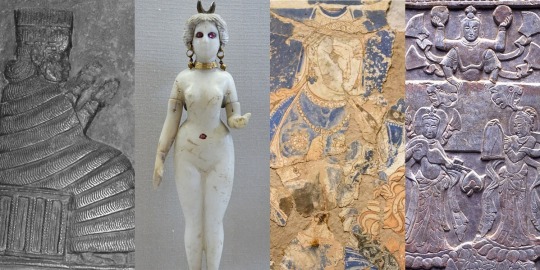
Being a major deity is not necessarily a guarantee of being remembered. Nanaya survived for longer than any other Mesopotamian deity, spread further away from her original home than any of her peers, and even briefly competed with both Buddha and Jesus for relevance. At the same time, even in scholarship she is often treated as unworthy of study. She has no popculture presence save for an atrocious, ill-informed SCP story which can’t get the most basic details right. Her claims to fame include starring in fairly explicit love poetry and appearing where nobody would expect her. Therefore, she is the ideal topic to discuss on this blog.
This is actually the longest article I published here, the culmination of over two years of research. By now, the overwhelming majority of Nanaya-related articles on wikipedia are my work, and what you can find under the cut is essentially a synthesis of what I have learned while getting there. I hope you will enjoy reading it as much as I enjoyed working on it.
Under the cut, you will learn everything there is to know about Nanaya: her origin, character, connections with other Mesopotamian deities, her role in literature, her cult centers… Since her history does not end with cuneiform, naturally the later text corpora - Aramaic, Bactrian, Sogdian and even Chinese - are discussed too. The article concludes with a short explanation why I see the study of Nanaya as crucial.
Dubious origins and scribal wordplays: from na-na to Nanaya
Long ago Samuel Noah Kramer said that “history begins in Sumer”. While the core sentiment was not wrong in many regards, in this case it might actually begin in Akkad, specifically in Gasur, close to modern Kirkuk. The oldest possible attestation of Nanaya are personal names from this city with the element na-na, dated roughly to the reign of Naram-Sin of Akkad, so to around 2250 BCE. It’s not marked in the way names of deities in personal names would usually be, but this would not be an isolated case.
The evidence is ultimately mixed. On one hand, reduplicated names like Nana are not unusual in early Akkadian sources, and -ya can plausibly be explained as a hypocoristic suffix. On the other hand, there is not much evidence for Nanaya being worshiped specifically in the far northeast of Mesopotamia in other periods. Yet another issue is that there is seemingly no root nan- in Akkadian, at least in any attested words.
The main competing proposal is that Nanaya originally arose as a hypostasis of Inanna but eventually split off through metaphorical mitosis, like a few other goddesses did, for example Annunitum. This is not entirely implausible either, but ultimately direct evidence is lacking, and when Nanaya pops up for the first time in history she is clearly a distinct goddess.
There are a few other proposals regarding Nanaya’s origin, but they are considerably weaker. Elamite has the promising term nan, “day” or “morning”, but Nanaya is entirely absent from the Old Elamite sources you’d expect to find her in if Mesopotamians imported her from the east. Therefore, very few authors adhere to this view. The hypothesis that she was an Aramaic goddess in origin does not really work chronologically, since Aramaic is not attested in the third millennium BCE at all. The less said about attempts to connect her to anything “Proto-Indo-European”, the better.
Like many other names of deities, Nanaya’s was already a subject of etymological speculation in antiquity. A late annotated version of the Weidner god list, tablet BM 62741, preserves a scribe’s speculative attempt at deriving it from the basic meaning of the sign NA, “to call”, furnished with a feminine suffix, A. Needless to say, like other such examples of scribal speculation, some of which are closer to playful word play than linguistics, it is unlikely to reflect the actual origin of the name.
Early history: Shulgi-simti, Nanaya’s earliest recorded #1 fan
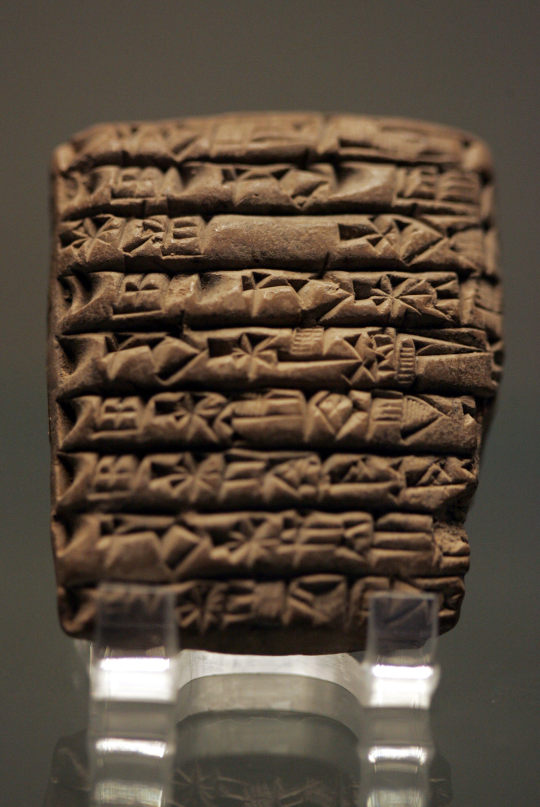
A typical Ur III administrative tablet listing offerings to various deities (wikimedia commons)
The first absolutely certain attestations of Nanaya, now firmly under her full name, have been identified in texts from the famous archive from Puzrish-Dagan, modern Drehem, dated to around 2100 BCE. Much can be written about this site, but here it will suffice to say that it was a center of the royal administration of the Third Dynasty of Ur ("Ur III") responsible for the distribution of sacrificial animals.
Nanaya appears there in a rather unique context - she was one of the deities whose cults were patronized by queen Shulgi-simti, one of the wives of Shulgi, the successor of the dynasty’s founder Ur-Namma.
We do not know much about Shulgi-simti as a person - she did not write any official inscriptions announcing her preferred foreign policy or letters to relatives or poetry or anything else that typically can be used to gain a glimpse into the personal lives of Mesopotamian royalty. We’re not really sure where she came from, though Eshnunna is often suggested as her hometown. We actually do not even know what her original name was, as it is assumed she only came to be known as Shulgi-simti after becoming a member of the royal family. Tonia Sharlach suggested that the absence of information about her personal life might indicate that she was a commoner, and that her marriage to Shulgi was not politically motivated
The one sphere of Shulgi-simti’s life which we are incredibly familiar with are her religious ventures. She evidently had an eye for minor, foreign or otherwise unusual goddesses, such as Belet-Terraban or Nanaya.
She apparently ran what Sharlach in her “biography” of her has characterized as a foundation. It was tasked with sponsoring various religious celebrations. Since Shulgi-simti seemingly had no estate to speak of, most of the relevant documents indicate she procured offerings from a variety of unexpected sources, including courtiers and other members of the royal family. The scale of her operations was tiny: while the more official religious organizations dealt with hundreds or thousands of sacrificial animals, up to fifty or even seventy thousand sheep and goats in the case of royal administration, the highest recorded number at her disposal seems to be eight oxen and fifty nine sheep.
A further peculiarity of the “foundation” is that apparently there was a huge turnover rate among the officials tasked with maintaining it. It seems nobody really lasted there for much more than four years. There are two possible explanations: either Shulgi-simti was unusually difficult to work with, or the position was not considered particularly prestigious and was, at the absolute best, viewed as a stepping stone.
While the Shulgi-simti texts are the earliest evidence for worship of Nanaya in the Ur III court, they are actually not isolated. When all the evidence from the reigns of Shulgi and his successors is summarized, it turns out that she quickly attained a prominent role, as she is among the twelve deities who received the most offerings. However, her worship was seemingly limited to Uruk (in her own sanctuary), Nippur (in the temple of Enlil, Ekur) and Ur. Granted, these were coincidentally three of the most important cities in the entire empire, so that’s a pretty solid early section of a divine resume. She chiefly appears in two types of ceremonies: these tied to the royal court, or these mostly performed by or for women. Notably, a festival involving lamentations (girrānum) was held in her honor in Uruk.
To understand Nanaya’s presence in the two aforementioned contexts, and by extension her persistence in Mesopotamian religion in later periods, we need to first look into her character.
The character of Nanaya: eroticism, kingship, and disputed astral ventures

Corona Borealis (wikimedia commons)
Nanaya’s character is reasonably well defined in primary sources, but surprisingly she was almost entirely ignored in scholarship quite recently. The first study of her which holds up to scrutiny is probably Joan Goodnick Westenholz’s article Nanaya, Lady of Mystery from 1997. The core issue is the alleged interchangeability of goddesses. From the early days of Assyriology basically up to the 1980s, Nanaya was held to be basically fully interchangeable with Inanna. This obviously put her in a tough spot. Still, over the course of the past three decades the overwhelming majority of studies came to recognize Nanaya as a distinct goddess worthy of study in her own right. You will still stumble upon the occasional “Nanaya is basically Inanna”, but now this is a minority position. Tragically it’s not extinct yet, most recently I’ve seen it in a monograph published earlier this year.
With these methodological and ideological issues out of the way, let’s actually look into Nanaya’s character, as promised by the title of this section. Her original role was that of a goddess of love. It is already attested for her at the dawn of her history, in the Ur III period. Her primary quality was described with a term rendered as ḫili in Sumerian and kuzbu in Akkadian. It can be variously translated as “charm”, “luxuriance”, “voluptuousness”, “sensuality” or “sexual attractiveness”. This characteristic was highlighted by her epithet bēlet kuzbi (“lady of kuzbu”) and by the name of her cella in the Eanna, Eḫilianna. The connection was so strong that this term appears basically in every single royal inscription praising her. She was also called bēlet râmi, “lady of love”. Nanaya’s role as a love goddess is often paired with describing her as a “joyful” or “charming” deity.
It needs to be stressed that Nanaya was by no metric the goddess of some abstract, cosmic love or anything like that. Love incantations and prayers related to love are quite common, and give us a solid glimpse into this matter. Nanaya’s range of activity in them is defined pretty directly: she deals with relationships (and by extension also with matters like one-sided crushes or arguments between spouses), romance and with strictly sexual matters. For an example of a hymn highlighting her qualifications when it comes to the last category, see here. The text is explicit, obviously.
We can go deeper, though. There is also an incantation whose incipit at first glance leaves little to imagination:

However, the translator, Giole Zisa, notes there is some debate over whether it’s actually about having sex with Nanaya or merely about invoking her (and other deities) while having sex with someone else. A distinct third possibility is that she’s not even properly invoked but that “oh, Nanaya” is simply an exclamation of excitement meant to fit the atmosphere, like a specialized version of the mainstay of modern erotica dialogue, “oh god”.
While this romantic and sexual aspect of Nanaya’s character is obviously impossible to overlook, this is not all there was to her. She was also associated with kingship, as already documented in the Ur III period. She was invoked during coronations and mourning of deceased kings. In the Old Babylonian period she was linked to investiture by rulers of newly independent Uruk.
A topic which has stirred some controversy in scholarship is Nanaya’s supposed astral role. Modern authors who try to present Nanaya as a Venus deity fall back on rather faulty reasoning, namely asserting that if Nanaya was associated with Inanna and Inanna personified Venus, clearly Nanaya did too. Of course, being associated with Inanna does not guarantee the same traits. Shaushka was associated with her so closely her name was written with the logogram representing her counterpart quite often, and lacked astral aspects altogether.
No primary sources which discuss Nanaya as a distinct, actively worshiped deity actually link her with Venus. If you stretch it you will find some tidbits like an entry in a dictionary prepared by the 10th century bishop Hasan bar Bahlul, who inexplicably asserted Nanaya was the Arabic name of the planet Venus. As you will see soon, there isn’t even a possibility that this reflected a relic of interpretatio graeca. The early Mandaean sources, many of which were written when at least remnants of ancient Mesopotamian religion were still extant, also do not link Nanaya with Venus. Despite at best ambivalent attitude towards Mesopotamian deities, they show remarkable attention to detail when it comes to listing their cult centers, and on top of that Mesopotamian astronomy had a considerable impact on Mandaeism, so there is no reason not to prioritize them, as far as I am concerned.
As far as the ancient Mesopotamian sources themselves go, the only astral object with a direct connection to Nanaya was Corona Borealis (BAL.TÉŠ.A, “Dignity”), as attested in the astronomical compendium MUL.APIN. Note that this is a work which assigns astral counterparts to virtually any deity possible, though, and there is no indication this was a major part of Nanaya’s character. Save for this single instance, she is entirely absent from astronomical texts.
A further astral possibility is that Nanaya was associated with the moon. The earliest evidence is highly ambiguous: in the Ur III period festivals held in her honor might have been tied to phases of the moon, while in the Old Babylonian period a sanctuary dedicated to her located in Larsa was known under the ceremonial name Eitida, “house of the month”. A poem in which looking at her is compared to looking at the moon is also known. That’s not all, though. Starting with the Old Babylonian period, she could also be compared with the sun. Possibly such comparisons were meant to present her as an astral deity, without necessarily identifying her with a specific astral body. Michael P. Streck and Nathan Wasserman suggest that it might be optimal to simply refer to her as a “luminous” deity in this context. However, as you will see later it nonetheless does seem she eventually came to be firmly associated both with the sun and the moon.
Last but not least, Nanaya occasionally displayed warlike traits. It’s hardly major in her case, and if you tried hard enough you could turn any deity into a war deity depending on your political goals, though. I’d also place the incantation which casts her as one of the deities responsible for keeping the demon Lamashtu at bay here.
Nanaya in art
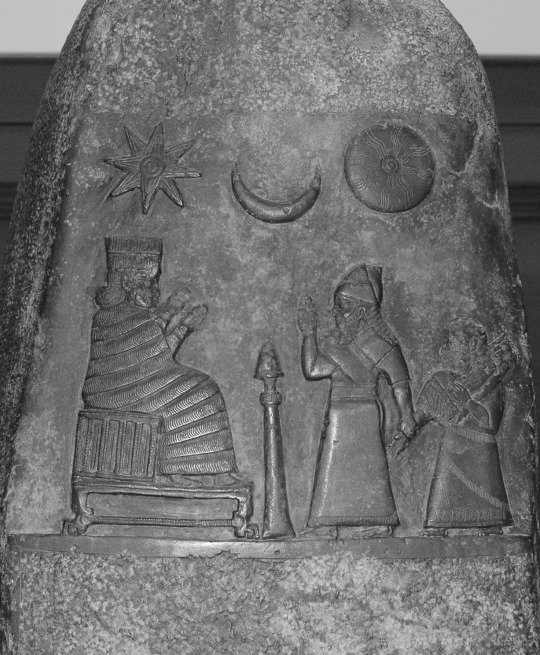
The oldest known depiction of Nanaya (wikimedia commons)
While Nanaya’s roles are pretty well defined, there surprisingly isn’t much to say about her iconography in Mesopotamian art.The oldest certain surviving depiction of her is rather indistinct: she’s wearing a tall headdress and a flounced robe. It dates to the late Kassite period (so roughly to 1200 BCE), and shows her alongside king Meli-Shipak (or maybe Meli-Shihu, reading remains uncertain) and his daughter Hunnubat-Nanaya. Nanaya is apparently invoked to guarantee that the prebend granted to the princess will be under divine protection. This is not really some unique prerogative of hers, perhaps she was just the most appropriate choice because Hunnubat-Nanaya’s name obviously reflects devotion to her.
The relief discussed above is actually the only depiction of Nanaya identified with certainty from before the Hellenistic period, surprisingly. We know that statues representing her existed, and it is hard to imagine that a popular, commonly worshiped deity was not depicted on objects like terracotta decorations and cylinder seals, but even if some of these were discovered, there’s no way to identify them with certainty. This is not unusual though, and ultimately there aren’t many Mesopotamian deities who can be identified in art without any ambiguity.
Nanaya in literature
As I highlighted in the section dealing with Nanaya’s character, she is reasonably well attested in love poetry. However, this is not the only genre in which she played a role.
A true testament to Nanaya’s prominence is a bilingual (Sumero-Akkadian) hymn composed in her honor in the first millennium BCE. It is written in the first person, and presents various other goddesses as her alternate identities. It is hardly unique, and similar compositions dedicated to Ishtar (Inanna), Gula, Ninurta and Marduk are also known.
Each strophe describes a different deity and location, but ends with Nanaya reasserting her actual identity with the words “still I am Nanaya”. Among the claimed identities included are both major goddesses in their own right (Inanna plus closely associated Annunitum and Ishara, Gula, Bau, Ninlil), goddesses relevant due to their spousal roles first and foremost (Damkina, Shala, Mammitum etc) and some truly unexpected, picks, the notoriously elusive personified rainbow Manzat being the prime example. Most of them had very little in common with Nanaya, so this might be less an attempt at syncretism, and more an elevation of her position through comparisons to those of other goddesses.
An additional possible literary curiosity is a poorly preserved myth which Wilfred G. Lambert referred to as “The murder of Anshar”. He argues that Nanaya is one of the two deities responsible for the eponymous act. I don't quite follow the logic, though: the goddess is actually named Ninamakalamma (“Lady mother of the land”), and her sole connection with Nanaya is that they occur in sequence in the unique god list from Sultantepe. Lambert saw this as a possible indication they are identical. There are no other attestations of this name, but ama kalamma does occur as an epithet of various goddesses, most notably Ninshubur. Given her juxtaposition with Nanaya in the Weidner god list - more on that later - wouldn’t it make more sense to assume it’s her? Due to obscurity of the text as far as I am aware nobody has questioned Lambert’s tentative proposal yet, though.
There isn’t much to say about the plot: Anshar, literally “whole heaven”, the father of Anu, presumably gets overthrown and might be subsequently killed. Something that needs to be stressed here to avoid misinterpretation: primordial deities such as Anshar were borderline irrelevant, and weren't really worshiped. They exist to fade away in myths and to be speculated about in elaborate lexical texts. There was no deposed cult of Anshar. Same goes for all the Tiamats and Enmesharras and so on.
Inanna and beyond: Nanaya and friends in Mesopotamian sources
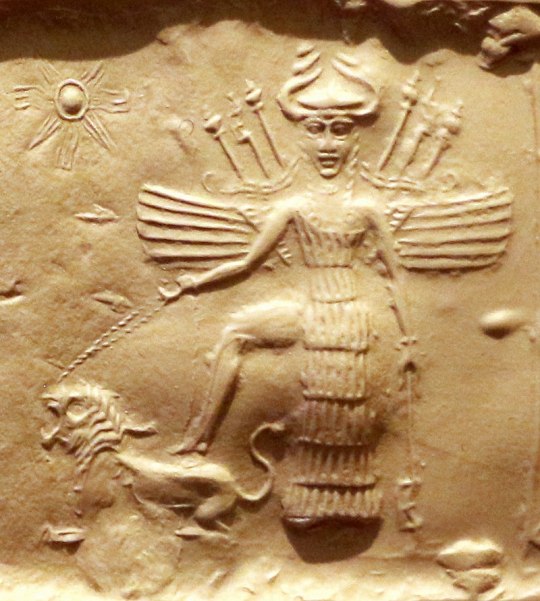
Inanna on a cylinder seal from the second half of the third millennium BCE (wikimedia commons)
Of course, Nanaya’s single most important connection was that to Inanna, no matter if we are to accept the view that she was effectively a hypostasis gone rogue or not. The relationship between them could be represented in many different ways. Quite commonly she was understood as a courtier or protegee of Inanna. A hymn from the reign of Ishbi-Erra calls her the “ornament of Eanna” (Inanna’s main temple in Uruk) and states she was appointed by Inanna to her position. References to Inanna as Nanaya’s mother are also known, though they are rare, and might be metaphorical. To my best knowledge nothing changed since Olga Drewnowska-Rymarz’s monograph, in which she notes she only found three examples of texts preserving this tradition. I would personally abstain from trying to read too deep into it, given this scarcity.
Other traditions regarding Nanaya’s parentage are better attested. In multiple cases, she “borrows” Inanna’s conventional genealogy, and as a result is addressed as a daughter of Sin (Nanna), the moon god. However, she was never addressed as Inanna’s sister: it seems that in cases where Sin and Nanaya are connected, she effectively “usurps” Inanna’s own status as his daughter (and as the sister of Shamash, while at it). Alternatively, she could be viewed as a daughter of Anu.
Finally, there is a peculiar tradition which was the default in laments: in this case, Nanaya was described as a daughter of Urash. The name in this context does not refer to the wife of Anu, though. The deity meant is instead a small time farmer god from Dilbat. To my best knowledge no sources place Nanaya in the proximity of other members of Urash’s family, though some do specify she was his firstborn daughter. To my best knowledge Urash had at least two other children, Lagamal (“no mercy”, an underworld deity whose gender is a matter of debate) and Ipte-bitam (“he opened the house”, as you can probably guess a divine doorkeeper). Nanaya’s mother by extension would presumably be Urash’s wife Ninegal, the tutelary goddess of royal palaces. There is actually a ritual text listing these three together.
In the Weidner god list Nanaya appears after Ninshubur. Sadly, I found no evidence for a direct association between these two. For what it’s worth, they did share a highly specific role, that of a deity responsible for ordering around lamma. This term referred to a class of minor deities who can be understood as analogous to “guardian angels” in contemporary Christianity, except places and even deities had their own lamma too, not just people. Lamma can also be understood at once as a class of distinct minor deities, as the given name of individual members of it, and as a title of major deities. In an inscription of Gudea the main members of the official pantheon are addressed as “lamma of all nations”, by far one of my favorite collective terms of deities in Mesopotamian literature.
A second important aspect of the Weidner god list is placing Nanaya right in front of Bizilla. The two also appear side by side in some offering lists and in the astronomical compendium MUL.APIN, where they are curiously listed as members of the court of Enlil. It seems that like Nanaya, she was a goddess of love, which is presumably reflected by her name. It has been variously translated as “pleasing”, “loving” or as a derivative of the verb “to strip”. An argument can be made that Bizilla was to Nanaya what Nanaya was to Inanna. However, she also had a few roles of her own. Most notably, she was regarded as the sukkal of Ninlil. She may or may not also have had some sort of connection to Nungal, the goddess of prisons, though it remains a matter of debate if it’s really her or yet another, accidentally similarly named, goddess.

An indistinct Hurro-Hittite depiction of Ishara from the Yazilikaya sanctuary (wikimedia commons)
In love incantations, Nanaya belonged to an informal group which also included Inanna, Ishara, Kanisurra and Gazbaba. I do not think Inanna’s presence needs to be explained. Ishara had an independent connection with Inanna and was a multi-purpose deity to put it very lightly; in the realm of love she was particularly strongly connected with weddings and wedding nights. Kanisurra and Gazbaba warrant a bit more discussion, because they are arguably Nanaya’s supporting cast first and foremost.
Gazbaba is, at the core, seemingly simply the personification of kuzbu. Her name had pretty inconsistent orthography, and variants such as Kazba or Gazbaya can be found in primary sources too. The last of them pretty clearly reflects an attempt at making her name resemble Nanaya’s. Not much can be said about her individual character beyond the fact she was doubtlessly related to love and/or sex. She is described as the “grinning one” in an incantation which might be a sexual allusion too, seeing as such expressions are a mainstay of Akkadian erotic poetry.
Kanisurra would probably win the award for the fakest sounding Mesopotamian goddess, if such a competition existed. Her name most likely originated as a designation of the gate of the underworld, ganzer. Her default epithet was “lady of the witches” (bēlet kaššāpāti). And on top of that, like Nanaya and Gazbaba she was associated with sex. She certainly sounds more like a contemporary edgy oc of the Enoby Dimentia Raven Way variety than a bronze age goddess - and yet, she is completely genuine.
It is commonly argued Kanisurra and Gazbaba were regarded as Nanaya’s daughters, but there is actually no direct evidence for this. In the only text where their relation to Nanaya is clearly defined they are described as her hairdressers, rather than children.
While in some cases the love goddesses appear in love incantations in company of each other almost as if they were some sort of disastrous polycule, occasionally Nanaya is accompanied in them by an anonymous spouse. Together they occur in parallel with Inanna and Dumuzi and Ishara and Almanu, apparently a (accidental?) deification of a term referring to someone without family obligations.
There is only one Old Babylonian source which actually assigns a specific identity to Nanaya’s spouse, a hymn dedicated to king Abi-eshuh of Babylon. An otherwise largely unknown god Muati (I patched up his wiki article just for the sake of this blog post) plays this role here.
The text presents a curious case of reversal of gender roles: Muati is asked to intercede with Nanaya on behalf of petitioners. Usually this was the role of the wife - the best known case is Aya, the wife of Shamash, who is implored to do just that by Ninsun in the standard edition of the Epic of Gilgamesh. It’s also attested for goddesses such as Laz, Shala, Ninegal or Ninmug… and in the case of Inanna, for Ninshubur.

A Neo-Assyrian statue of Nabu on display in the Iraq Museum (wikimedia commons)
Marten Stol seems to treat Muati and Nabu as virtually the same deity, and on this basis states that Nanaya was already associated with the latter in the Old Babylonian period, but this seems to be a minority position. Other authors pretty consistently assume that Muati was a distinct deity at some point “absorbed” by Nabu.
The oldest example of pairing Nanaya with Nabu I am aware of is an inscription dated to the reign of Marduk-apla-iddina I, so roughly to the first half of the twelfth century BCE. The rise of this tradition in the first millennium BCE was less theological and more political. With Babylon once again emerging as a preeminent power, local theologies were supposed to be subordinated to the one followed in the dominant city. Which, at the time, was focused on Nabu, Marduk and Zarpanit. Worth noting that Nabu also had a spouse before, Tashmetum (“reconciliation”). In the long run she was more or less ousted by Nanaya from some locations, though she retained popularity in the north, in Assyria. She is not exactly the most thrilling deity to discuss. I will confess I do not find the developments tied to Nanaya and Nabu to be particularly interesting to cover, but in the long run they might have resulted in Nanaya acquiring probably the single most interesting “supporting cast member” she did not share with Inanna, so we’ll come back to this later.
Save for Bizilla, Nanaya generally was not provided with “equivalents” in god lists. I am only aware of one exception, and it’s a very recent discovery. Last year the first ever Akkadian-Amorite bilingual lists were published. This is obviously a breakthrough discovery, as before Amorite was largely known just from personal names despite being a vernacular language over much of the region in the bronze age, but only one line is ultimately of note here. In a section of one of the lists dealing with deities, Nanaya’s Amorite counterpart is said to be Pidray. This goddess is otherwise almost exclusively known from Ugarit. This of course fits very well with the new evidence: recent research generally stresses that Ugarit was quintessentially an Amorite city (the ruling house even claimed descent from mythical Ditanu, who is best known from the grandiose fictional genealogies of Shamshi-Adad I and the First Dynasty of Babylon).
Sadly, we do not know how the inhabitants of Ugarit viewed Nanaya. A trilingual version of the Weidner list, with the original version furnished with columns listing Ugaritic and Hurrian counterparts of each deity, was in circulation, but the available copies are too heavily damaged to restore it fully. And to make things worse, much of it seems to boil down to scribal wordplay and there is no guarantee all of the correspondences are motivated theologically. For instance, the minor Mesopotamian goddess Imzuanna is presented as the counterpart of Ugaritic weather god Baal because her name contains a sign used as a shortened logographic writing of the latter. An even funnier case is the awkward attempt at making it clear the Ugaritic sun deity Shapash, who was female, is not a lesbian… by making Aya male. Just astonishing, really.
The worship of Nanaya
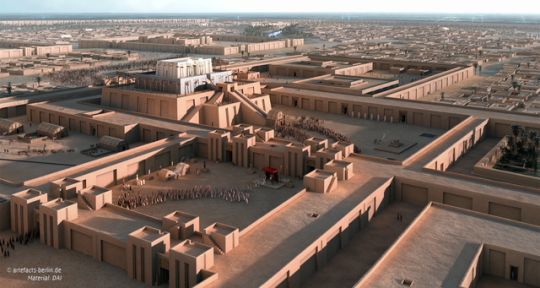
A speculative reconstruction of Ur III Uruk with the Eanna temple visible in the center (Artefacts — Scientific Illustration & Archaeological Reconstruction; reproduced here for educational purposes only, as permitted)
Rather fittingly, as a deity associated with Inanna, Nanaya was worshiped chiefly in Uruk. She is also reasonably well attested in the inscriptions of the short-lived local dynasty which regained independence near the end of the period of domination of Larsa over Lower Mesopotamia. A priest named after her, a certain Iddin-Nanaya, for a time served as the administrator of her temple, the Enmeurur, “house which gathers all the me,” me being a difficult to translate term, something like “divine powers”. The acquisition of new me is a common topic in Mesopotamian literature, and in compositions focused on Inanna in particular, so it should not be surprising to anyone that her peculiar double seemingly had similar interests.
In addition to Uruk, as well as Nippur and Ur, after the Ur III period Nanaya spread to multiple other cities, including Isin, Mari, Babylon and Kish. However, she is probably by far the best attested in Larsa, where she rose to the rank of one of the main deities, next to Utu, Inanna, Ishkur and Nergal. She had her own temple, the Eshahulla, “house of a happy heart”. In local tradition Inanna got to keep her role as an “universal” major goddess and her military prerogatives, but Nanaya overtook the role of a goddess of love almost fully. Inanna’s astral aspect was also locally downplayed, since Venus was instead represented in the local pantheon by closely associated, but firmly distinct, Ninsianna. This deity warrants some more discussion in the future just due to having a solid claim to being one of the first genderfluid literary figures in history, but due to space constraints this cannot be covered in detail here.
A later inscription from the same city differentiates between Nanaya and Inanna by giving them different epithets: Nanaya is the “queen of Uruk and Eanna” (effectively usurping Nanaya’s role) while Inanna is the “queen of Nippur” (that’s actually a well documented hypostasis of her, not to be confused with the unrelated “lady of Nippur”).
Uruk was temporarily abandoned in the late Old Babylonian period, but that did not end Nanaya’s career. Like Inanna, she came to be temporarily relocated to Kish. It has been suggested that a reference to her residence in “Kiššina” in a Hurro-Hittite literary text, the Tale of Appu, reflects her temporary stay there.
The next centuries of Nanaya are difficult to reconstruct due to scarce evidence, but it is clear she continued to be worshiped in Uruk. By the Neo-Babylonian period she was recognized as a member of an informal pentad of the main deities of the city, next to Inanna, Urkayitu, Usur-amassu and Beltu-sa-Resh. Two of them warrant no further discussion: Urkayitu was most likely a personification of the city, and Beltu-sa-Resh despite her position is still a mystery to researchers.
Usur-amassu, on the contrary, is herself a fascinating topic. First attestations of this deity, who was seemingly associated with law and justice (a pretty standard concern), come back to the Old Babylonian period. At this point, Usur-amassu was clearly male, which is reflected by the name. He appears in the god list An = Anum as a son of the weather deity couple par excellence, Adad (Ishkur) and Shala. However, by the early first millennium BCE Usur-amassu instead came to be regarded as female - without losing the connection to her parents. She did however gain a connection to Inanna, Nanaya and Kanisurra, which she lacked earlier. How come remains unknown. Most curiously her name was not modified to reflect her new gender, though she could be provided with a determinative indicating it. This recalls the case of Lagamal in the kingdom of Mari some 800 years earlier.
The end of the beginning: Nanaya under Achaemenids and Seleucids
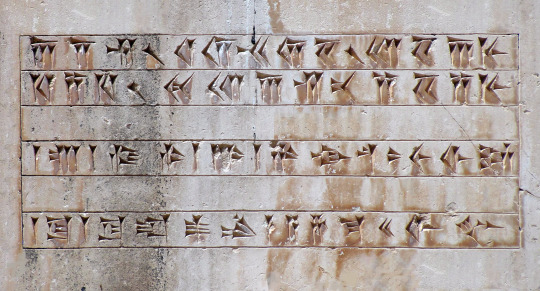
Trilingual (Persian, Elamite and Akkadian) inscription of the first Achamenid ruler of Mesopotamia, Cyrus (wikimedia commons)
After the fall of the Neo-Babylonian Empire Mesopotamia ended up under Achaemenid control, which in turn was replaced by the Seleucids. Nanaya flourished through both of these periods. In particular, she attained considerable popularity among Arameans. While they almost definitely first encountered her in Uruk, she quickly came to be venerated by them in many distant locations, like Palmyra, Hatra and Dura Europos in Syria. She even appears in a single Achaemenid Aramaic papyrus discovered in Elephantine in Egypt. It indicates that she was worshiped there by a community which originated in Rash, an area east to the Tigris. As a curiosity it’s worth mentioning the same source is one of the only attestations of Pidray from outside Ugarit. I do not think this has anything to do with the recently discovered connection between her and Nanaya… but you may never know.
Under the Seleucids, Nanaya went through a particularly puzzling process of partial syncretism. Through interpretatio graeca she was identified with… Artemis. How did this work? The key to understanding this is the fact Seleucids actually had a somewhat limited interest in local deities. All that was necessary was to find relatively major members of the local pantheon who could roughly correspond to the tutelary deities of their dynasty: Zeus, Apollo and Artemis. Zeus found an obvious counterpart in Marduk (even though Marduk was hardly a weather god). Since Nabu was Marduk’s son, he got to be Apollo. And since Nanaya was the most major goddess connected to Nabu, she got to be Artemis. It really doesn’t go deeper than that.
For what it’s worth, despite the clear difference in character this newfound association did impact Nanaya in at least one way: she started to be depicted with attributes borrowed from Artemis, namely a bow and a crescent. Or perhaps these attributes were already associated with her, but came to the forefront because of the new role. The Artemis-like image of Nanaya as an archer is attested on coins, especially in Susa, yet another city where she attained considerable popularity.
Leaving Mesopotamia: Nanaya and the death of cuneiform
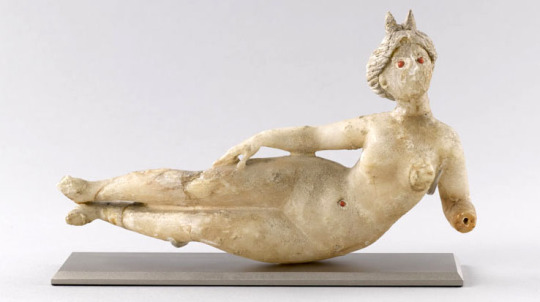
A Parthian statue of Nanaya with a crescent diadem (Louvre; reproduced here for educational purposes only. Identification follows Andrea Sinclair's proposal)
The Seleucid dynasty was eventually replaced by the Parthians. This period is often considered a symbolic end of ancient Mesopotamian religion in the strict sense. Traditional religious institutions were already slowly collapsing in Achaemenid and Seleucid times as the new dynasties had limited interest in royal patronage. Additionally, cuneiform fell out of use, and by the end of the first half of the first millennium CE the art of reading and writing it was entirely lost. This process did not happen equally quickly everywhere, obviously, and some deities fared better than others in the transitional period before the rise of Christianity and Islam as the dominant religions across the region. Nanaya was definitely one of them, at least for a time.
In Parthian art Nanaya might have developed a distinct iconography: it has been argued she was portrayed as a nude figure wearing only some jewelry (including what appears to be a navel piercing and a diadem with a crescent. The best known example is probably this standing figure, one of my all time favorite works of Mesopotamian art:

Parthian Nanaya (wikimedia commons; identification courtesy of the Louvre website and J. G. Westenholz)
For years Wikipedia had this statue mislabeled as “Astarte” which makes little sense considering it comes from a necropolis near Babylon. There was also a viral horny tweet which labeled it as “Asherah” a few months ago (I won’t link it but I will point out in addition to getting the name wrong op also severely underestimated the size). This is obviously even worse nonsense both on spatial and temporal grounds. Even if the biblical Asherah was ever an actual deity like Ugaritic Athirat and Mesopotamian Ashratum, it is highly dubious she would still be worshiped by the time this statue was made. It’s not even certain she ever was a deity, though. Cognate of a theonym is not automatically a theonym itself, and the Ugaritic texts and the Bible, even if they share some topoi, are separated by centuries and a considerable distance. This is not an Asherah post though, so if this is a topic which interests you I recommend downloading Steve A. Wiggins’ excellent monograph A Reassessment of Asherah: With Further Considerations of the Goddess.
The last evidence for the worship of Nanaya in Mesopotamia is a Mandaean spell from Nippur, dated to the fifth or sixth century CE. However, at this point Nanaya must have been a very faint memory around these parts, since the figure designated by this name is evidently male in this formula. That was not the end of her career, though. The system of beliefs she originated and thrived in was on its way out, but there were new frontiers to explore.
A small disgression is in order here: be INCREDIBLY wary of claims about the survival of Mesopotamian tradition in Mesopotamia itself past the early middle ages. Most if not all of these come from the writing of Simo Parpola, who is a 19th century style hyperdiffusionist driven by personal religious beliefs based on gnostic christianity, which he believes was based on Neo-Assyrian state religion, which he misinterprets as monotheism, or rather proto-christianity specifically (I wish I was making this up). I personally do not think a person like that should be tolerated in serious academia, but for some incomprehensible reason that isn’t the case.
New frontiers: Nanaya in Bactria
The key to Nanaya’s extraordinarily long survival wasn’t the dedication to her in Mesopotamia, surprisingly. It was instead her introduction to Bactria, a historical area in Central Asia roughly corresponding to parts of modern Afghanistan, Tajikistan and Uzbekistan. The early history of this area is still poorly known, though it is known that it was one of the “cradles of civilization” not unlike Mesopotamia, the Indus Valley or Mesoamerica. The so-called “Oxus civilization” or “Bactria-Margiana Archaeological Complex” flourished around 2500-1950 BCE (so roughly contemporarily with the Akkadian and Ur III empires in Mesopotamia). It left behind no written records, but their art and architecture are highly distinctive and reflect great social complexity.
I sadly can’t spent much time discussing them here though, as they are completely irrelevant to the history of Nanaya (there is a theory that she was already introduced to the east when BMAC was extant but it is incredibly implausible), so I will limit myself to showing you my favorite related work of art, the “Bactrian princess”:

Photo courtesy of Louvre Abu Dhabi, reproduced here for educational purposes only.
By late antiquity, which is the period we are concerned with here, BMAC was long gone, and most of the inhabitants of Bactria spoke Bactrian, an extinct Iranian language. How exactly they were related to their BMAC forerunners is uncertain. Their religious beliefs can be compared to Zoroastrianism, or rather with its less formalized forerunners followed by most speakers of Iranian languages before the rise of Zoroaster. However, there were many local peculiarities. For example, the main deity was the personified river Oxus, not Ahura Mazda. Whether this was a relic of BMAC religion is impossible to tell.We do not know exactly when the eastward transfer of Nanaya to Bactria happened. The first clear evidence for her presence in central Asia comes from the late first century BCE, from the coins of local rulers, Sapadbizes and Agesiles. It is possible that her depictions on coinage of Mesopotamian and Persian rulers facilitated her spread. Of course, it’s also important to remember that the Aramaic script and language spread far to the east in the Achaemenid period already, and that many of the now extinct Central Asian scripts were derived from it (Bactrian was written with the Greek script, though). Doubtlessly many now lost Aramaic texts were transferred to the east.
There’s an emerging view that for unclear reasons, under the Achaemenids Mesopotamian culture as a whole had unparalleled impact on Bactria. The key piece of evidence are Bactrian temples, which often resemble Mesopotamian ones. Therefore, perhaps we should be wondering not why Nanaya spread from Mesopotamia to Central Asia, but rather why there were no other deities who did, for the most part. That is sadly a question I cannot answer. Something about Nanaya simply made her uniquely appealing to many groups at once.
While much about the early history of Nanaya in Central Asia is a mystery, it is evident that with time she ceased to be viewed as a foreign deity. For the inhabitants of Bactria she wasn’t any less “authentically Iranian” than the personified Oxus or their versions of the conventional yazatas like Sraosha. Frequently arguments are made that Nanaya’s widespread adoption and popularity could only be the result of identification between her and another deity.Anahita in particular is commonly held to be a candidate. However, as stressed by recent studies there’s actually no evidence for this.
What is true is that Anahita is notably missing from the eastern Iranian sources, despite being prominent in the west from the reign of the Achaemenid emperor Artaxerxes II onward. However, it is clear that not all yazatas were equally popular in each area - pantheons will inevitably be localized in each culture. Furthermore, Anahita’s character has very little in common with Nanaya save for gender. Whether we are discussing her early not quite Zoroastrian form the Achaemenid public was familiar with or the contemporary yazata still relevant in modern Zoroastrianism, the connection to water is the most important feature of her. Nanaya didn’t have such a role in any culture.
Recently some authors suggested a much more obvious explanation for Anahita’s absence from the eastern Iranian pantheon(s). As I said, eastern Iranian communities venerated the river Oxus as a deity (or as a yazata, if you will). He was the water god par excellence, and in Bactria also the king of the gods. It is therefore quite possible that Anahita, despite royal backing from the west, simply couldn’t compete with him. Their roles overlapped more than the roles of Anahita and Nanaya. I am repeating myself but the notion of interchangeability of goddesses really needs to be distrusted almost automatically, no matter how entrenched it wouldn’t be. While we’re at it, the notion of alleged interchangeability between Anahita and Ishtar is also highly dubious, but that’s a topic for another time.

Nana (Nanaya) on a coin of Kanishka (wikimedia commons)
Nanaya experienced a period of almost unparalleled prosperity with the rise of the Kushan dynasty in Bactria. The Kushans were one of the groups which following Chinese sources are referred to as Yuezhi. They probably did not speak any Iranian language originally, and their origin is a matter of debate. However, they came to rule over a kingdom which consisted largely of areas inhabited by speakers of various Iranian languages, chiefly Bactrian. Their pantheon, documented in royal inscriptions and on coinage, was an eerie combination of mainstays of Iranian beliefs like Sraosha and Mithra and some unique figures, like Oesho, who was seemingly the reflection of Hindu Shiva. Obviously, Nanaya was there too, typically under the shortened name Nana.
The most famous Kushan ruler, emperor Kanishka, in his inscription from Rabatak states that kingship was bestowed upon him by “Nana and all the gods”. However, we do not know if the rank assigned to her indicates she was the head of the dynastic pantheon, the local pantheon in the surrounding area, or if she was just the favorite deity of Kanishka. Same goes for the rank of numerous other deities mentioned in the rest of the inscription. Her apparent popularity during Kanishka’s reign and beyond indicates her role should not be downplayed, though.
The coins of Kanishka and other Bactrian art indicate that a new image of Nanaya developed in Central Asia. The Artemis-like portrayals typical for Hellenistic times continue to appear, but she also started to be depicted on the back of a lion. There is only one possible example of such an image from the west, a fragmentary relief from Susa, and it’s roughly contemporary with the depictions from Bactria. While it is not impossible Nanaya originally adopted the lion association from one of her Mesopotamian peers, it is not certain how exactly this specific type of depictions originally developed, and there is a case to be made that it owed more to the Hellenistic diffusion of iconography of deities such as Cybele and Dionysus, who were often depicted riding on the back of large felines.
The lunar symbols are well attested in the Kushan art of Nanaya too. Most commonly, she’s depicted wearing a diadem with a crescent. However, in a single case the symbol is placed behind her back. This is an iconographic type which was mostly associated with Selene at first, but in the east it was adopted for Mah, the Iranian personification of the moon. I’d hazard a guess that’s where Nanaya borrowed it from - more on that later.
The worship of Nanaya survived the fall of the Kushan dynasty, and might have continued in Bactria as late as in the eighth century. However, the evidence is relatively scarce, especially compared with yet another area where she was introduced in the meanwhile.
Nanaya in Sogdia: new home and new friends
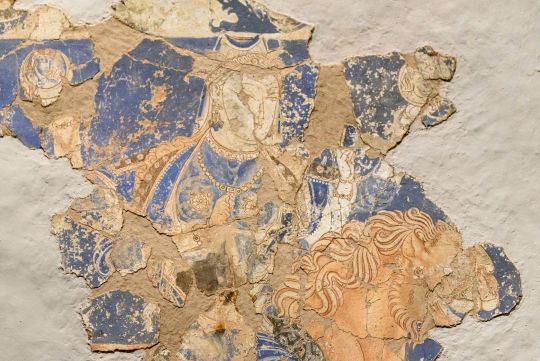
A Sogdian depiction of Nanaya from Bunjikat (wikimedia commons)
Presumably from Bactria, Nanaya was eventually introduced to Sogdia, its northern neighbor. I think it’s safe to say this area effectively became her new home for the rest of her history.
Like Bactrians, the Sogdians also spoke an eastern Iranian language, Sogdian. It has a direct modern descendant, Yaghnobi, spoken by a small minority in Tajikistan. The religions Sogdians adhered to is often described as a form of Zoroastrianism, especially in older sources, but it would appear that Ahura Mazda was not exactly the most popular deity. Their pantheon was seemingly actually headed by Nanaya. Or, at the very least, the version of it typical for Samarkand and Panijkant, since there’s a solid case to be made for local variety in the individual city-states which made up Sogdia. It seems that much like Mesopotamians and Greeks centuries before them, Sogdians associated specific deities with specific cities, and not every settlement necessarily venerated each deity equally (or at all). Nanaya's remarkable popularity is reflected by the fact the name Nanaivandak, "servant of Nanaya", is one of the most common Sogdian names in general.
It is agreed that among the Sogdians Panjikant was regarded as Nanaya’s cult center. She was referred to as “lady” of this city. At one point, her temple located there was responsible for minting the local currency. By the eighth century, coins minted there were adorned with dedications to her - something unparalleled in Sogdian culture, as the rest of coinage was firmly secular. This might have been an attempt at reasserting Sogdian religious identity in the wake of the arrival of Islam in Central Asia.
Sogdians adopted the Kushan iconography of Nanaya, though only the lion-mounted version. The connection between her and this animal was incredibly strong in Sogdian art, with no other deity being portrayed on a similar mount. There were also innovations - Nanaya came to be frequently portrayed with four arms. This reflects the spread of Buddhism through central Asia, which brought new artistic conventions from India. While the crescent symbol can still be found on her headwear, she was also portrayed holding representations of the moon and the sun in two of her hands.
Sometimes the solar disc and lunar orb are decorated with faces, which has been argued to be evidence that Nanaya effectively took over the domains of Mah and Mithra, who would be the expected divine identities of these two astral bodies. She might have been understood as controlling the passage of night and day. It has also been pointed out that this new iconographic type is the natural end point of the evolution of her astral role.
Curiously, while no such a function is attested for Nanaya in Bactria, in Sogdia she could be sometimes regarded as a warlike deity. This is presumably reflected in a painting showing her and an unidentified charioteer fighting demons.

The "Sogdian Deities" painting from Dunhuang, a possible depiction of Nanaya and her presumed spouse Tish (wikimedia commons)
Probably the most fascinating development regarding Nanaya in Sogdia was the development of an apparent connection between her and Tish. This deity was the Sogdian counterpart of one of the best known Zoroastrian yazatas, Tishtrya, the personification of Sirius. As described in the Tištar Yašt, the latter is a rainmaking figure and a warlike protector who keeps various nefarious forces, such as Apaosha, Duzyariya and the malign “worm stars” (comets), at bay. Presumably his Sogdian counterpart had a similar role.
While this is not absolutely certain, it is generally agreed that Nanaya and Tish were regarded as a couple in central Asia (there’s a minority position she was instead linked with Oesho, though). Most likely the fact that in Achaemenid Persia Tishtrya was linked with Nabu (and by extension with scribal arts) has something to do with this. There is a twist to this, though.
While both Nabu and the Avestan Tishtrya are consistently male, in Bactria and Sogdia the corresponding deity’s gender actually shows a degree of ambiguity. On a unique coin of Kanishka, Tish is already portrayed as a feminine figure distinctly similar to Greek Artemis - an iconographic type which normally would be recycled for Nanaya. There’s also a possibility that a feminine, or at least crossdressing, version of Tish is portrayed alongside Nanaya on a painting from Dunhuang conventionally referred to as “Sogdian Daēnās” or “Sogdian Deities”, but this remains uncertain. If this identification is correct, it indicates outright interchange of attributes between them and Nanaya was possible.
The final frontier: Nanaya and the Sogdian diaspora in China
Sogdians also brought Nanaya with them to China, where many of them settled in the Six Dynasties and Tang periods. An obviously Sinicized version of her, accompanied by two attendants of unknown identity, is portrayed on a Sogdian funerary couch presently displayed in the Miho Museum.
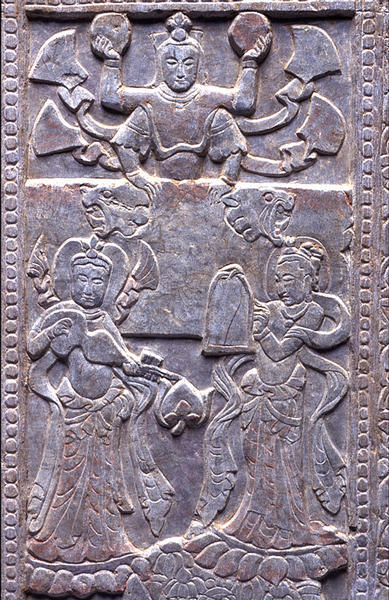
Nanaya (top) on a relief from the Miho funerary couch (Miho Museum; reproduced here for educational purposes only)
For the most part the evidence is limited to theophoric names, though. Due to unfamiliarity with Sogdian religious traditions and phonetic differences between the languages there was no consistent Chinese transcription of Nanaya’s name. I have no clue if Chinese contemporaries of the Sogdians were always aware of these elements in personal names referred to a deity. There is a fringe theory that Nanaya was referred to as Nantaihou (那那女主, “queen Nana”) in Chinese. However, the evidence is apparently not compelling, and as I understand the theory depends in no small part on the assertion that a hitherto unattested alternate reading of one of the signs was in use on the western frontiers of China in the early first millennium CE. The alleged Nantaihou is therefore most likely a misreading of a reference to a deceased unnamed empress dowager venerated through conventional ancestor worship, as opposed to Nanaya.
Among members of the Sogdian diaspora, in terms of popularity Nanaya was going head to head with Jesus and Buddha. The presence of the latter two reflected the adoption of, respectively, Manichaeism and Buddhism. Manicheans seemingly were not fond of Nanaya, though, and fragments of a polemic against her cult have been identified. It seems ceremonies focused on lamentations were the main issue for the Manichaeans. Sadly there doesn’t seem to be any worthwhile study of possible Mesopotamian influence on that - the only one I found is old and confuses Nanaya with Inanna.
We do not have much of an idea how Buddhists viewed Nanaya, though it is worth noting a number of other Sogdian deities were incorporated into the local form of Mahayana (unexpectedly, one of them was Zurvan). It has also been argued that a Buddhist figure, Vreshman (Vaisravana) was incorporated into Nanaya’s entourage.
Nanaya might additionally be depicted in a painting showing Buddha’s triumph over Mara from Dunhuang. Presumably her inclusion would reflect the well attested motif of local deities converting to Buddhism. It was a part of the Buddhist repertoire from the early days of this religion and can be found in virtually every area where this religion ever spread. Nanaya is once again in elevated company here, since other figures near her have been tentatively interpreted as Shiva, Vishnu, Kartikeya and… Zoroaster.
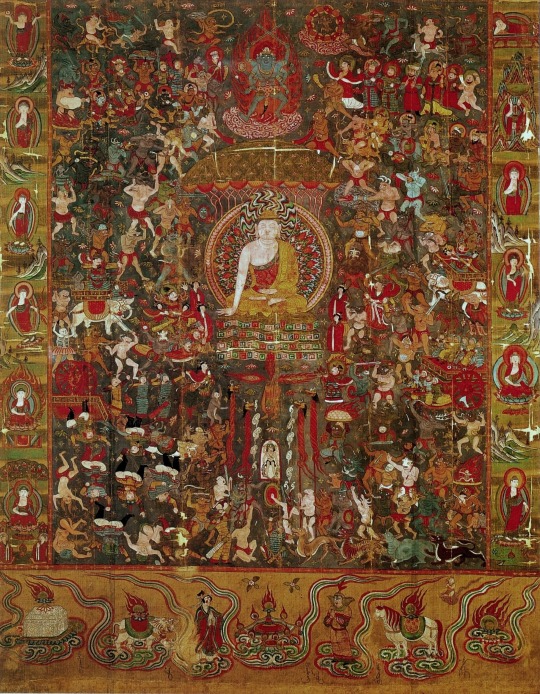
Buddha conquering Mara (maravijaya) on a painting from Dunhuang (wikimedia commons)

zoom in on a possible depiction of Nanaya next to a demon suspiciously similar to Tove Jansson’s Fillyjonk
To my best knowledge, the last absolutely certain attestation of Nanaya as an actively worshiped deity also comes from the western frontier of China. A painting from Dandan Oilik belonging to the artistic tradition of the kingdom of Khotan shows three deities from the Sogdian pantheon: the enigmatic Āδβāγ (“highest god”; interpreted as either Indra, Ahura Mazda or a combination of them both) on the left, Weshparkar (a later version of Kushan Oesho) on the right and Nanaya in the center. It dates to the ninth or tenth century.
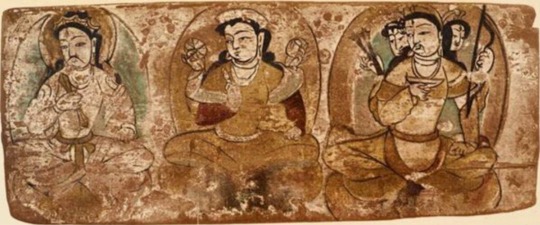
Nanaya (center) on the Dandan Oilik painting (wikimedia commons)
We will probably never know what Nanaya’s last days were like, though it is hard to imagine she retained much relevance with the gradual disappearance of Sogdian culture both in Sogdia and in China in the wake of, respectively, the rise of Islam in Central Asia and the An Lushan rebellion respectively. Her history ultimately most likely ended with a whimper rather than a bang.
Conclusions and reflections
Obviously, not everything about Nanaya could be covered in this article - there is enough material to warrant not one, but two wiki articles (and I don't even think they are extensive enough yet). I hope I did nonetheless manage to convey what matters: she was the single most enduring Mesopotamian deity who continued to be actually worshiped. She somehow outlived Enlil, Marduk, Nergal and even Inanna, and spread further than any of them ever did.
It does not seem like her persistence was caused by some uniquely transcendent quality, and more to a mix of factors we will never really fully understand and pure luck. She is a far cry from the imaginary everlasting universal goddesses such longevity was attributed to by many highly questionable authors in the past, from Frazer to Gimbutas. Quite the opposite, once you look into the texts focused on her she comes across as sort of pathetic. After all, most of them are effectively ancient purple prose.
And yet, this is precisely why I think Nanaya matters. To see how an author approaches her is basically a litmus test of trustworthiness - I wish I was kidding but this “Nanaya method” works every time. To even be able to study her history, let alone understand it properly, one has to cast away most of the dreadful trends which often hindered scholarship of ancient deities, and goddesses in particular, in the past. The interchangeability of goddesses; the Victorian mores and resulting notion that eroticism must be tied to fertility; the weird paradigms about languages neatly corresponding to religions; and many others. And if nothing else, this warrants keeping the memory of her 3000 years long history alive through scholarship (and, perhaps, some media appearances).
Bibliography
Julia M. Asher-Greve & Joan Goodnick Westenholz, Goddesses in Context: On Divine Powers, Roles, Relationships and Gender in Mesopotamian Textual and Visual Sources (2013)
Paul-Alain Beaulieu, The Pantheon of Uruk During the Neo-Babylonian Period (2003)
idem, Nabû and Apollo: The Two Faces of Seleucid Religious Policy in: Orient und Okzident in Hellenistischer Zeit (2014)
Matteo Compareti, Nana and Tish in Sogdiana (2017)
idem, The So-Called "Pelliot Chinois 4518.24". Illustrated Document from Dunhuang and Sino-Sogdian Iconographical Contacts (2021)
Olga Drewnowska-Rymarz, Mesopotamian Goddess Nanāja (2008)
Benjamin R. Foster, Before the Muses: an Anthology of Akkadian Literature (2005)
Andrew R. George & Manfred Krebernik, Two Remarkable Vocabularies: Amorite-Akkadian Bilinguals! (2022)
Valerie Hansen, Kageyama Etsuko & Yutaka Yoshida, The Impact of the Silk Road Trade on a Local Community: The Turfan Oasis, 500-800 in: Les sogdiens en Chine (2005)
Wilfred G. Lambert, Babylonian Creation Myths (2013)
Enrico Marcato, An Aramaic Incantation Bowl and the Fall of Hatra (2020)
Christa Müller-Kessler & Karlheinz Kessler, Spätbabylonische Gottheiten in spätantiken mandäischen Texten (1999)
Lilla Russel-Smith, Uygur Patronage in Dunhuang. Regional Art Centres on the Northern Silk Road in the Tenth and Eleventh Centuries (2005)
idem, The 'Sogdian Deities' Twenty Years on: A Reconsideration of a Small Painting from Dunhuang in: Buddhism in Central Asia II. Practices and Rituals, Visual and Material Transfer (2022)
Tonia M. Sharlach, An Ox of One's Own. Royal Wives and Religion at the Court of the Third Dynasty of Ur (2017)
Michael Shenkar, Intangible Spirits and Graven Images: The Iconography of Deities in the Pre-Islamic Iranian World (2014)
idem, The Religion and the Pantheon of the Sogdians (5th-8th Centuries CE) in Light of their Sociopolitical Structures (2017)
idem, The So-Called "Fravašis" and the "Heaven and Hell" Paintings, and the Cult of Nana in Panjikent (2022)
Marten Stol, Nanaja in: Reallexikon der Assyriologie, vol. 9 (1998)
Michael P. Streck & Nathan Wasserman, More Light on Nanāya (2013)
Aaron Tugendhaft, Gods on Clay: Ancient Near Eastern Scholarly Practices and the History of Religions in: Canonical Texts and Scholarly Practices. A Global Comparative Approach (2016)
Joan Goodnick Westenholz, Nanaya, Lady of Mystery in: Sumerian Gods and Their Representations (1997)
idem, Trading the Symbols of the Goddess Nanaya in: Religions and Trade. Religious Formation, Transformation and Cross-Cultural Exchange between East and West (2014)
Xinjiang Rong, The Colophon of the Manuscript of the Golden Light Sutra Excavated in Turfan and the Transmission of Zoroastrianism to Gaochang in: The Silk Road and Cultural Exchanges between East and West (2022)
Gioele Zisa, The Loss of Male Sexual Desire in Ancient Mesopotamia. ›Nīš Libbi‹ Therapies (2021)
#mesopotamian mythology#sumerian mythology#mythology#bactrian mythology#sogdian mythology#sogdia#nanaya
419 notes
·
View notes
Text
I See You, Darling (4)

[Astarion x reader] A little longer than usual, I hope that’s fine for all of you :,DDD I didn't want to cram too much into the post though, so the segment at the end might be continued in full detail, or maybe not! Let's see.|Word count: 2.9k.|
Content Warnings: Mentions of cooking, handling knives, blood, allusions to sex, a few ooc characters, reader being a dumbass and wahtnot.
Part 3 here!!
Masterlist here!!
A party is being held at the camp in the heroes’ honor, which greets you with a lively crowd that you’ll hopefully meet again soon. And with a gathering this large, you’re bound to garner attention. But with a constitution as poor as yours from the night before, a round of drinks is the last thing you want.
Alternatively: A bloodless human tries to balance respectfully participating in a drinking party, while also not drinking at all.
————━─━────༺༻────━─━————
The sun rises, the warmth of its rays gently waking you in the absence of the campfire’s flames. The soft chirping of the birds greet you a good morning as your eyes slowly open, ready to greet the day as a new opportunity arises.
Is what would have happened in a more idyllic scenario. Instead, you bolt awake with a pounding headache, worse than any hangover could possibly feel like, and quickly rush to get up. By the sheer brightness of the light that burns your newly opened corneas, it is far later than when you usually wake. And breakfast still hasn’t been made.
“Well, good morning sleepy head.” One of your companions, Gale, says as he fixes his belongings. Readying himself for the skirmish that was about to take hold later on in the day.
“I’m very sorry for waking up late. It won’t happen again.” You bow your head low for a moment before he waves you off.
“Oh come now, we all have our off days. Besides, I think the rest would agree with me when I say what you made for us last night was more than enough to last us ‘til morning.” His statement is punctuated by the lively sounds of the others training. Ready and well rested for whatever may come.
You look around. None have seemed to mind your temporary absence, so you endeavor to double check with everyone leaving and ensure that they had a sound strategy with the necessary materials and weapons should there be a need for failsafes. You remind them of certain notes that some of them have informed you about but failed to share with the rest of the group.
‘While goblins typically go down faster than other opponents, they have no sense of honor nor pride which gives way for them the opportunity to use more underhanded tactics. But they also aren’t very bright, so you can convince the others to let them infiltrate the camp and eradicate them from the inside out.’
As the rest disperse, finalize their plans and check their supplies, your favorite character approaches you much like he usually does every morning. Only this time, you see that he looks very pleased. A more vibrant spark in his eyes as he opens his mouth to speak.
“Thank goodness you’ve finally woken up.” He looks at you, in the same way an old friend of yours would when they’re seconds away from telling a joke.
The look fades soon enough though as he breathes out. You wonder if it’s because the joke isn't funny anymore, or if he never had a punchline to begin with.
“You looked a little ill last night, but you’ve certainly recovered.” Recovered isn’t the word you would use to describe your current state of feeling almost half dead, but you don’t bother correcting the details.
“And you look particularly vibrant today, Astarion.” The itch of your neck intensifies as you return a pointed look at him as he frowns.
“Oh, of course! Now, don’t be so upset. I will admit that I got a little carried away, I apologize.” He pauses. The frown remains on his face for a while before it is erased with his usual expression of confidence.
“But let’s not fall out over this.” He moves to stand closer to you, taking your hand to his as he nears it to his lips as he continues.
“We need each other.”
And whether its done purposefully or not, you see his fangs peek out from his mouth and a shiver courses through your body.
You slip your hand out of his own in a panic and interject.
“I know that much already, and I trust you not to let what happened last night happen again. I also apologize for not noticing sooner and dealing with the situation better.” You hold your head down a bit to apologize but quickly meet his gaze gain. “But I do need to know what we’ll have to feed you from now on.”
The look of confusion, and perhaps even shock that was once swimming in his eyes dissipates before you can notice them when he swears upon his resolve. “No innocents, you have my word. After all, you know what I am now. I can fight with all my weapons–” He grins, allowing you a clearer view than what you had earlier. “Teeth included.”
“And if I happen to drain the occasional bandit during a fight, what's the harm? They’re just as dead.” He makes a very compelling argument, at least to your standards.
You sigh, satisfied for now. You’re confident that none of your party members would end up at the mercy of his fangs, and you’re more than sure they would be able to overpower him more than your attempts did. But the same sentiment cannot be shared for possibly important, plot driving, characters that you might meet later on.
So you propose something to strengthen your trust that the unlikely will stay the unlikely.
“Look, I’m–” You breathe in, almost as if you're trying to suck back whatever courage washed over you back in as you steeled yourself for what you were about to say next.
“I’m not against you feeding from me, but!” You punctuate the last syllable as you see his grin growing wider. “We need to discuss things beforehand. No prowling over me while waiting for me to wake up or to sink your teeth into.”
The proposal greatly delights him, as is evident in his response. “Of course! That sounds eminently reasonable. I shall wait patiently until you suggest we… dine together. But until then: no more late-night surprises. You have my word on that.”
After that, he makes a joke about feeling ‘peckish already,’ and quickly gathers the rest of the party to leave on their adventure.
You promise them a feast when they came back as the victors that they are. What you forgot, after what felt like weeks in the real world, was the crowd that would come filtering in to celebrate their heroes’ achievements as well.
————————————
When you saw the tieflings from the grove traveling alongside your companions, you knew they had come to celebrate. And you blanched at the thought of the provisions they’d be seeking to pair with their drinking. It’s been so long since you went through this event, and you no longer recall if they even ate anything during the party.
You look at your bubbling cauldron–– a bigger one as you had anticipated a few acquaintances accompanying them–– but you wager that at least a little extra things to nibble on won’t hurt to have. You still have quite the amount of camp supplies in the trunk, but you keep it reserved for the camp’s use only. So you smile at your returning comrades and alert the others that stayed behind for your reason to leave and that they can begin eating dinner.
While others told you it wasn’t necessary, the rest just nodded with a smile and yelled that they’d wait for you to return. You return quite too quickly though, all the while informing them why you’re keeping the communal chest in your tent as you spy the child that tried to steal and swindle the group a few days prior approaching with the rest.
They have a laugh and you quickly proceed with your plan to find at least a few consumable berries and nuts or seeds to accompany the drinks later on.
But foraging for said consumables near dark is a choice not for the faint-hearted. You came to realize this when you heard the low grumble of a large animal, thankfully far from your form. You turn to look behind you, taking great care to do so as slowly as possible so as to not alert the mysterious creature.
In the clearing, you spot a rather dark looking bear and you feel a cold sweat begin to form on your temple. Hands, growing wet in the dangerous situation you’ve placed yourself in. This wasn’t the same as being drained to death by a vampire, that, you could at least reason with. But a wild animal? With your lack of magical prowess and lesser knowledge of connecting with nature and the wild, you would be finished if it were to follow you.
The small pouch of nuts and wild berries stayed holstered on your waist, but the bear’s eyes that were previously low on the ground are now trained on you. Almost as if it were caught doing something it wasn’t supposed to be.
You freeze. You forgot what the basic policy was around brown or black bears and therefore couldn’t do much about your current predicament. There shouldn’t be a bear around this area, not unless they had traveled from far away, or that this bear was one of your future companions.
And while the latter isn’t impossible, you most certainly did not want to gamble your life on a possibility. So you tried to compose yourself, returned the gaze of the bear with a shaky and careful nod, and turned back to return to camp. Figuring that the amount of tidbits you gathered would have to suffice.
When you return, the company you shared seems to be in high spirits. Some more than others. But conversation was plentiful and you smiled as the tieflings cheered for your comrades. You quickly got to work and began to chop the nuts into thinner pieces. Something you learned to make the appearance of something look more abundant than it really is.
While you were chopping away unfortunately, you nick your finger along the way and silently curse. Unfortunate, but not an unforeseeable outcome given the booming drums of the bard that plays oh so nicely with your bloodless state. You quickly, but neatly, arrange the provisions on two small platters, and position them near the larger gatherings.
“Flitting around like a hummingbird as always, I see.” A familiar, but not immediately recognizable voice greets you as you pass them. You turn and you see an unexpected acquaintance with a bottle in their hand and an incredibly charming grin.
“Dammon! How lucky of me to run into you.” You genuinely were elated to see him. You didn’t see much of him later on in the game, and being able to interact with him beyond the opportunities given to you was certainly nice.
“I could say the same. Though you’re as lively as you usually are.” There’s no malice in his tone, only an innocent observation, yet you feel embarrassed to have been seen scuttling about like a bug.
“I– promise I’m more organized. I just didn’t expect us to be having any guests.” He takes notice of how you push your fingers into your palms repetitively, a small action that soothes you.
“I think you’ve done more than a fine job already. The celebration is for you all, and it was us who planned to come and might’ve put your friends on the spot.” He later takes notice of the cut on your finger as well.
“Speaking of,” He gingerly grasps your hand, looking to you for permission, but you’re too confused to respond with anything he can understand. “Shouldn’t you be taking it easy for the night? You’ve done enough. And if what happened at the grove tells me anything about you, I’m sure they’ll survive even if you settle. Just for a bit.”
He leads you nearer to the water and produces a small washcloth to clean a bit of your finger as you respond. “The grove? They did that on their own. I just um, take notes.” You sit on a fallen tree, your head still fuzzy, as you observe his crouched form. Inspecting the cut as he cleans it.
A curious interaction. Not one that you’d expect from an non-romanceable NPC, but an interesting one nonetheless. And it would seem that someone had found it equally as interesting, if the way he scrutinizes you had anything to do about it.
He chuckles in turn. “If modesty is how you like to live, then I won’t impose.” He smiles and gets up as you continue your conversation. You don’t recall if the tiefling has ever had this much screen time, but his voice is rather lovely so you don’t complain about it.
You end up discussing quite a bit, but you focus on what can be done about your party. Specifically Karlach as you worry for the future and you’d like to have answers for her when he isn’t around during your journey. He doesn’t have much idea of what else can be done, but he does mention that he should have something by the time you meet him again in Baldur’s Gate.
You do remember that you might meet him a lot sooner, but you don’t mention it explicitly. You do, however, advise him to be extra careful around the oxen as they can be rather unpredictable this time of year.
As you continue, you notice his eyes flit up every now and then. Like something was catching his attention ever so often. You ask him about it and he actually laughs at your genuine inquiry. “It looks like I was wrong. Your friend there looks like he’d like his turn for your company.”
You turn around and you don’t immediately eye anyone looking in your direction. You were never the subtle type, so you looked around, blatantly searching for someone. It was a bit odd to see.
Your eyes do eventually train on his, but he doesn’t necessarily look like he wants to talk to you. Sure, he’s scowling away, though that’s not out of the ordinary at all. Besides, he has a bottle of something that you hope is helping him relax.
Still, perhaps Dammon saw something you didn’t so you politely thank him for his company and excuse yourself.
You greet the others that regard you as you walk past them. Declining the offers to drink and excusing yourself politely when you were asked to stay a bit.
As you approach him, a tiefling tries to strike up a conversation with him. With a bored look, he dismisses them and turns to look at you. He takes a sip, sneers, and begins his rant now that you’re situated in front of him.
“I hate it. This is awful.”
“The…wine?” He looks at you as if he should be mad, but a hint of amusement surfaces past the expression anyway.
“There’s that, but I’m talking about the tieflings. We killed some goblins to save the others. The tally of lives didn’t change much. But what do I get for my hard work? A pat on the head, and vinegar for wine.” He looks down the neck of the bottle, swirling its contents before handing it out for you to take.
You look at the bottle, then him, warily. Modern alcohol is already a wonder to you, and this medieval mead could only do so much worse. Still, you take the bottle, and take a very small sip.
It’s a heavy, rich, red. Dry and sharp. You make a small sound of shock as you keep the liquid in your mouth. Offering him an awkward smile and a nod as you do.
“Ugh, see what I mean? Awful.”
“All I want is a little fun. Is that so much to ask?” You would think that after an entire day of fighting whatever was out there he’d be tired. Apparently not.
You sigh, ready to reprimand him and that he should just enjoy the night, but you stop when you feel his unburdened hand reach out to you. Eyes, boring into your own as he propositions you.
You’re here. Face in the grasp of a character you’ve longed to romance with what little time you’ve had away from your scholarly pursuits. Yet meeting him in strange, yet not all too unfamiliar, territory stirs uncertainty within you. Because while he doesn't have a knife at your throat like he did when your character first met him, it certainly does evoke the same sentiment.
‘To, “make me his”, is that right?’ While the idea is tempting, that statement alone can have various interpretations. And you didn’t want to hedge your bets on the one that made your heart race for all the wrong reasons.
Thankfully, he releases his hold on your visage. Only the gods know how much his touch alone can influence you, and you struggle to stand upright.
“I’m– very,-- truly, sorry, but don’t you think you have the wrong person? I mean,” You gesture to yourself with both hands, a cut visible from the labor in the few hours prior to the large festivities going on.. “Uh…in case you haven’t noticed, I’m not exactly in a position to make any um, lucrative offers.”
He looks at you, a familiar expression graces his face. He leans his weight on one leg, and you struggle to recognize what his body language is conveying. This is one of those instances you wished you had the dice roll mechanic of the game at your disposal.
“Why, that hardly matters, darling. What matters is that you’re here.” He takes a sip from his bottle, the very same that he allowed you to partake from moments prior. Only this time, without the sneer at the aftertaste as he continues.
“But then again, what’s a sinner to do when faced with the very embodiment of chastity?” A smile graces his face, but it’s one that is all too perfect. As if he’s rehearsed the same song and dance enough to save him lifetimes.
“Let’s wait until things quieten down. Once the others are asleep we’ll find each other.”
You have no idea what to expect. Well, you do, but you’re not very sure if this is necessary. You’ll just have to find a way to continue the story without having to go through with this. For now, at least.
“We’ll see about that, Astarion.”
————━─━────༺༻────━─━————
Thank you to @rey26, @shyminnie07, @lynnloveshobi, @iggee-rose, @automnepoet, @tiannamortis, @aoirohi, @sarkara211, @jane-3043, @h3110-dar1in9, @h3ll0k1ttyl0ver333, @mimziethealien, @squichymochi, @sharabay, @furblrwurblr, @dork-of-the-universe, @thedevilssinner, @fuckalrighty, @queenofthespacesquids, @perseny, @goldenplutus, @h4nluv, @awkward-d3rs3-dr3amer, @auszimbo, @maruichio, @iamsexytrash, @craig-mywifeisdead-boone, @grimissleepy, @fandomsfanman, @bitchyzombienacho, @r1kk, @ancuninstar, @izuoyarmin, @gracemisconduct, @kiinokochii, @marina-and-the-memes, and @life-is-hard-m8 for asking to be tagged!!
#astarion ancunin x reader#astarion x reader#astarion ancunin#astarion x mc#aware!astarion#baldur's gate 3 x reader#astarion x you#bg3 x reader#bg3 x reader isekai(?)#possibly also a Dammon x reader?#slight!!#Slight Dammon x reader
520 notes
·
View notes
Text
"something floral": literature student blabbering about the usage of flower symbolism in "nevermore", how it ties to the theme of insanity and a little bit (a lot) about shakespeare.

from lenore's perspective, flowers are closely associated with isolation caused by her trauma and supposed "hysteria". floral pattern wallpaper accompanied her loneliness for days, months, even years. image of the flowers signaled that lenore's position would remain unchanged, that she was stuck, that she would continue to slowly loosing the clarity of her mind.
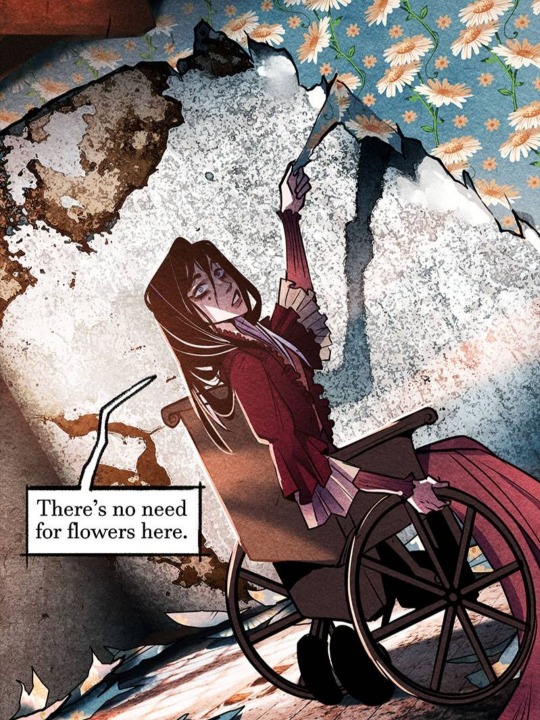
having torn the wallpaper off the walls, lenore believes that she will never see this image again, but flowers continue to accompanying her. lenore sees them again during her first meeting with annabel lee. and during the last one, too. she may have managed to get out of her lonely room, gain more strength in her legs, find a new friend, but lenore is still trapped. she's the daughter disowned by her parents, a stain on the family reputation that must be hidden forever. the image of flowers doesn't let her forget about it.
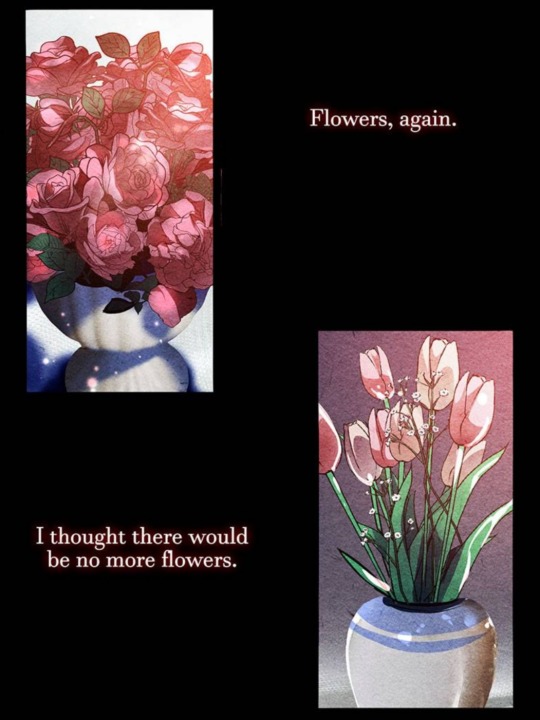

similar symbolism is also not alien to annabel lee. episode 66 is interesting in particular, because it directly quotes ophelia's monologue. I'm a big fan of shakespeare, it was he who instilled in me an interest in floral symbolism. a year ago, for a conference on foreign literature, I wrote an article about flower language of "hamlet". it's not available in english, but I'll list down some points that I considered relevant regarding "nevermore".
• rosemary can serve as a keepsake between lovers and also between the dead and the living. it could be seen at both weddings and funerals. in the old days it was also believed to be helpful in mental illnesses treatment.
• pansies, just like violets, symbolize innocence and devotion. ophelia doesn't consider the people around her worthy of violets, since she blames them for the death of her father.
• rue is a symbol of eternal suffering; grieving over her murdered father and the loss of her beloved hamlet, ophelia leaves some of the flowers for herself.
• the image of daisies has a close connection with the concepts of innocence, fidelity and eternal love. in shakespeare's tragedy, this symbol is overshadowed by the fact that in the world around ophelia there's no place for these beautiful things. for "nevermore" the symbol is also not so positive, since the readers are already familiar with daisies. they were on that wallpaper in lenore's room.
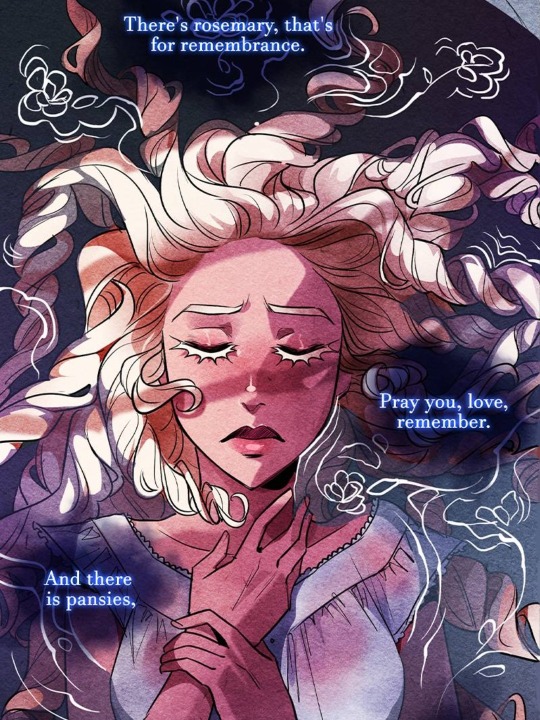
it's impossible not to note that annabel lee recites the monologue while in the bath, in the water. ophelia decides not to resist the river flow. her life turned into a tragedy: she was left without a father, her lover has seemingly lost his mind. her own sanity is also called into question. ophelia sings cryptic songs, goes into the field to weave a wreath, gives flowers to other characters. in the eyes of those around them, hamlet and ophelia seem crazy, while being the only sane and honest people among them. there's no place for tender, innocent ophelia in a cruel, deceitful world, so she drowns.
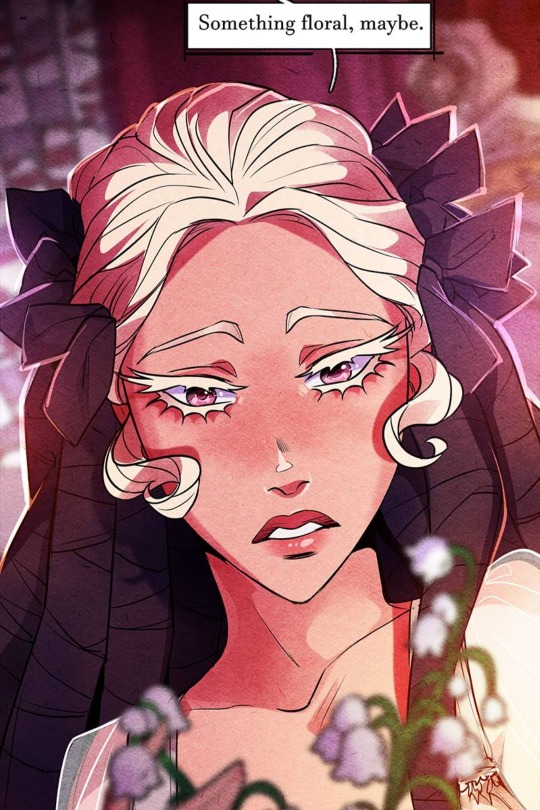
annabel lee also reflects on how both she and lenore are considered madwomen. her meeting with "leo" is accompanied by floral pattern on the annabel's dress. their madness is contextual, they both are perfectly sane, but don't fit into the system that could be leading to real madness with time. "all madwomen die twice. at least twice".
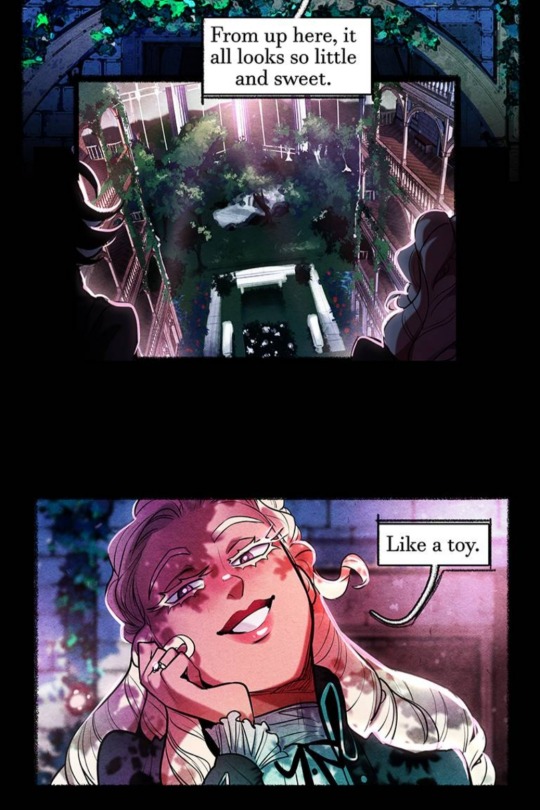
now about the arboretum. it obviously has a lot of flowers, but in my opinion this place is interesting in a different context. lenore and annabel visited the arboretum twice to discuss upcoming plans and such, and there are many parallels, both visual and narrative. not much time has passed since last time, but their situation has changed. they seem to look on their past selves from the upper level, having their conflict more acute now. I'll make a more detailed post about it later.
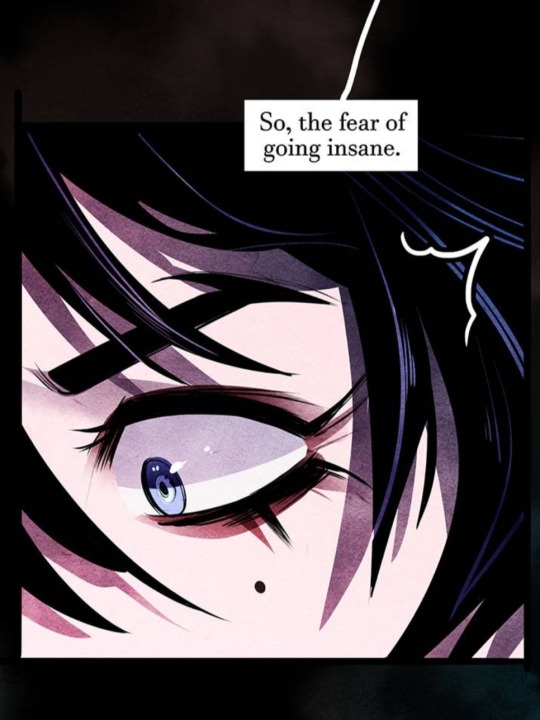
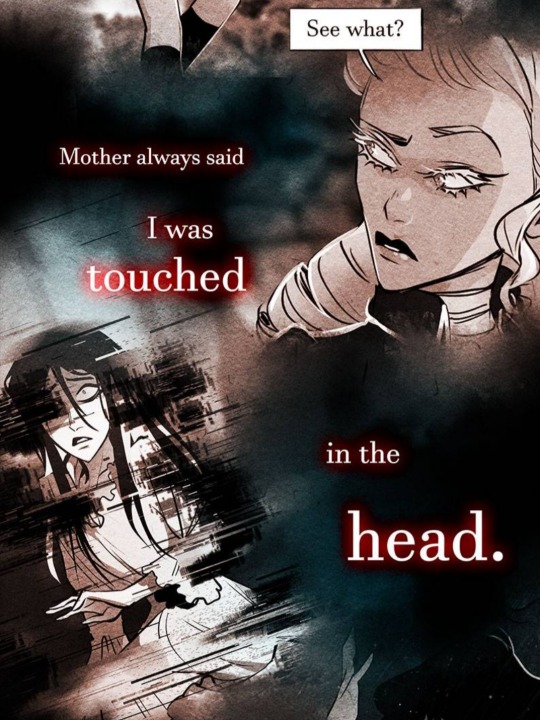
and now I'll just focus on how the characters in this arboretum full of roses behave as lost and confused as in the phobia-inducing flower labyrinth from earlier episodes. “the closer you get to beautiful flowers, the closer you get to their thorns,” says duke in episode 38. the flower imagery haunting the main characters doesn't let them forget that their sanity is always on a verge of slipping. and once a flower falls from its stem, it cannot be fixed.
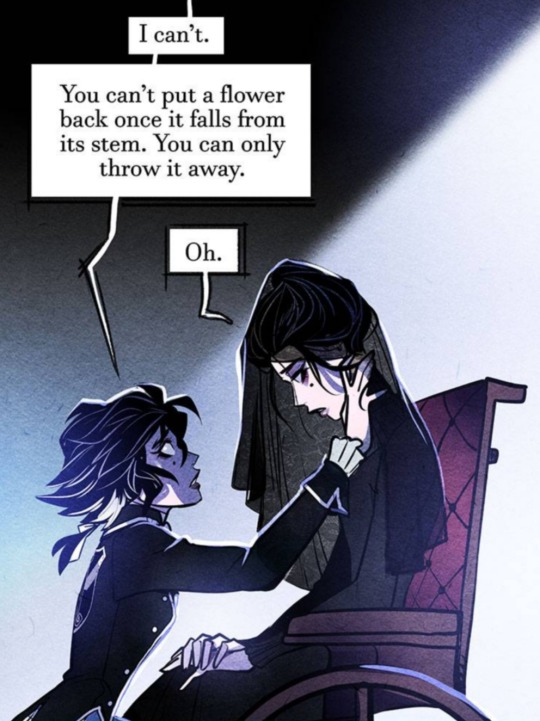
p.s. guess which writer’s works I chose for a new article this year?
#nevermore webtoon#nevermore theory#am i a total loser for spending so much time on this post#yeah absolutely#but im glad i got to share my thoughts#lenore nevermore#annabel lee nevermore#annabel lee x lenore#nevermore webcomic
328 notes
·
View notes
Text

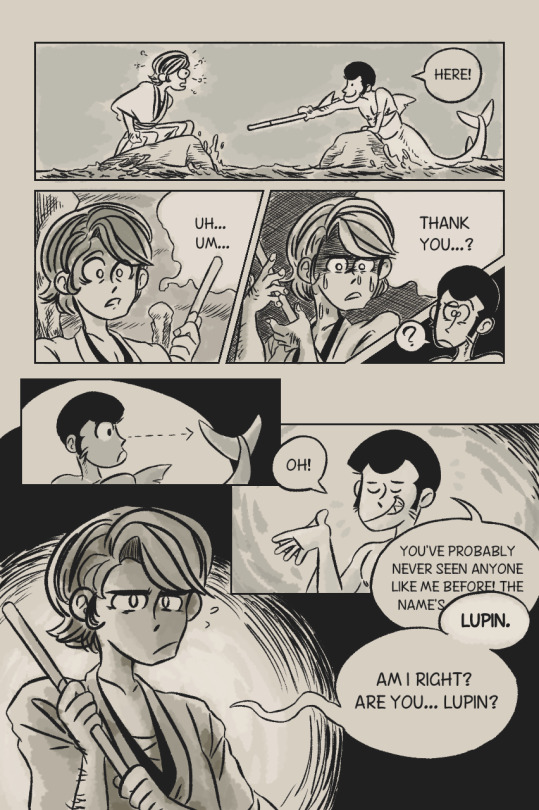
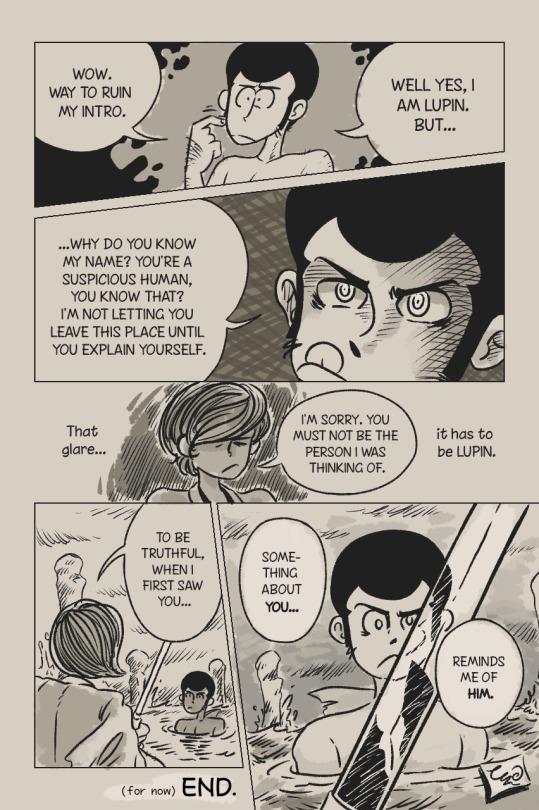
Lupin Week 2024 Day 4: AUs and Mythology
Goemon's face looks like he's seen a ghost.
ahhhh god ok my stupid stupid silly au i made a year ago.... this will be a bit long so get ready
tldr: lupin died, the gang is alive. goemon finds lupin but he's a shark merman!? and lupin remembers nothing!!!
long version:
so this AU follows upon the story of shin lupin, which basically, the gang gets killed off by zenigata because he rigged an island full of explosives.
instead of them all dying however, lupin decides to knock the gang unconscious and find a way for them to escape off the island safely, leaving only him in the island to die.
the rest of the gang had no idea how they escaped and assumed that lupin had sacrificed himself for them. they woke up adrifted on the ocean until they eventually got picked up by a ship where the invisible captain from new adventures returns. but ah ill spare the details for another day
---
2 years have passed and the gang just kinda separated to do their own thing. we'll only focus on goemon cuz he's the featured character of this comic.
goemon decided to escape the life of crime that has burdened him for years living as a part of the lupgang. he's mostly a wanderer now and tries to do good and help people along the way
funnily enough, goemon is not the first person to find lupin, but I'll talk about this later. but goemon is definitely very mixed about seeing his friend who he thought was dead for years. he doesn't know whether to be happy or worried.
---
lupin, at the brink of death after the explosion, plummets down the ocean and wakes up one day, feeling like he's been rebirthed!
essentially, lupin became a merman because right before he could die, his body (i mean what's left of it 💀) interacted with a magic crystal that has the ability to grant life to a living being.
It's really rare, but it exists in clusters deep in the ocean floor or- deep under the rocks of an island :) you can say im bullshitting, which i am but i dont think exploding an entire island down to every rock has happened before, so it can kinda make sense why something so coincidental about these crystals could happen. (I AM TOTALLY MAKING EXCUSES I JUST WANTED TO MAKE LUPIN A MERMAN.)
and so these crystals used whats left of lupins body and reassembled him back, and idk other essences of the ocean to make him a merman!
the memories of his past life have definitely been buried deep inside his brain to the point he can't remember any of it though, so he thinks that he was born under the ocean and has lived there for his entire life. other than that he retains almost everything about himself, down to stealing stupid shit and messing with humans just for the fucks of it. he's kinda seen as like a nessie.
---
anyways, y'know how i said goemon wasn't the first one to meet lupin? that's because lupin has met zenigata before!
living a life with only fishes around means lupin's kinda lonely and likes to stalk humans sometimes. the interaction with him and zenigata did not end well though, and lupin has no idea why zeni wants him dead so much.
after that he's way more cautious around people that look like zenigata- hatted big men with guns. its gonna be fun once he sees jigen.
ok what else... i think that's all i want to reveal now. will i do more of this? maybe. maybe not. kinda embarrassed of this because of how silly it is but i hope you people find this interesting! byebye
#lupin iii#lupin the third#lupin iii manga#goemon ishikawa xiii#peaterookie art#shin lupin iii#lupinweek2024#lupin au#merman#merman lupin
203 notes
·
View notes
Text
THE CHAIN -> e. roundtree
PART ONE: drummers' curse



PAIRING: eddie roundtree x fem!reader
WARNINGS: mentions of minor injuries (NOTE: some warnings for this story include MAJOR spoilers for this series down the line, so I'll put those beneath the cut. If you don't want to get the story spoiled, then just ignore it ― but I did want to provide the chance for you to get an idea of how the story will go later down the line if you have any sensitive topics you'd like to avoid. please prioritize your mental wellbeing!)
AUTHOR'S NOTE: Apologies in advance for making Y/n the drummer and putting Warren on rhythmic guitar. I just loooooooove female drummers. Also can you tell that I love Karen and Camila? Because I love them with alllllll my heart and soul. Another sorry in advance because this one may break your heart a little ― it sure broke mine.
NOTES ON THE WORK: I used the timeline from the book, mostly because I couldn't keep track of it in the show haha. I read the book twice before watching what episodes of the show were out, so the lines may blur between the two. For your convenience (and mine, tbh), I'll put the year all the characters were born underneath this note so you can reference it when you need to. I just couldn't keep track honestly. I think in the show they start the band when Graham is fourteen, but in the book he's around 18 when they add Warren on, so it's kind of confusing?? I decided to stick with the book because it was a more physical timeline. Anyways, enough talking, here's your guide!
― YEARS BORN (in order of age)
Billy Dunne -> 1947
Camila Dunne -> 1949
Graham Dunne -> 1949
Warren Rhodes -> 1949
Eddie Roundtree -> 1949
Daisy Jones -> 1951
Y/n L/n -> 1951
WARNINGS (SPOILERS INCLUDED): reader has a terminal illness. Discussions about death and loss, depictions of grief, hospitals

It's no secret that the renowned 1970s band Daisy Jones & The Six went through its fair share of ups and downs. Until their inexplicable split on July 12, 1979, they were undeniably one of the biggest bands in the world.
While a more detailed account of the band's history will be recounted in a more thorough transcript, this advanced edition will focus specifically on two of the band members: Eddie Roundtree and Y/n L/n.
More specifically, it will focus on their individual and combined roles they played in the band's eventual downfall.

THE RISE OF THE SIX (1965 - 1972)
GRAHAM: Y/n grew up next door to us. She was a little younger, two years or so, so we never really gave her a second look. Until the day she wandered into our garage during band practice out of nowhere. She practically ripped the drum sticks out of Chuck's hand and just started...wailing on 'em. I mean, she could make your head spin. Here was this thirteen, fourteen year old girl next door, this kid, and she was the best fuckin' drummer we'd seen. I mean, in the neighborhood. She wasn't Mitch Mitchell, but she was the closest thing we had. And she was too good to be shoved in the back with a tambourine. But we couldn't just take Chuck's spot away and hand it over to the new girl.
CHUCK: I knew right then and there that they wanted to give my spot to the new girl. There was no doubt in my mind. And, you know what? I got it. This chick was good. Way too good. Did I feel threatened by her? Hell yeah, I did. And at the time I probably wanted to tell her to screw off, but now...now I get it.
EDDIE: She was good. Amazing, actually. Graham and I looked at each other and knew that she was something we'd be stupid to pass up on.
BILLY: When Chuck told us he wanted out, we were pissed, of course. We were heading off to open for Winters that week. It felt like things were going to look up, just like I always knew they would, and he was ditching. I know now that that wasn't really what it was ― he'd gotten into college, fan-fucking-tastic. It was a good opportunity for him, a sure thing. But right then it felt like a betrayal.
WARREN: So he ditched, and Billy just turned right to Eddie and said, "Go tell Y/n she's in." And he was just...terrified.
EDDIE: I said, "why me?" You know? It wasn't my band, it was Billy's. And here he was, ordering me to tell some new girl she was in. I was fifteen and could barely ask a waitress for ketchup. At the time, that was probably the last thing I wanted to do.
GRAHAM: He asked why it had to be him, and I told him the truth: he was the least intimidating. Billy, you know him. He had a tendency to get too focused on the task at hand and could get a little...harsh. And Warren? He had one of the biggest personalities you could find. He'd scare her off before we had a chance to offer her the spot...[Pauses] I probably could've done it, in all honesty. I just didn't want to screw it up. Eddie was better with words than I was, and we needed her in our band. Badly.
EDDIE: And I remember thinking, "Here goes fucking nothing."

The doorbell ringing was what got her attention. No one ever used the doorbell. It was always a knock ― that, or someone just walked in. The L/n's front door was hardly ever locked back then. Y/n's mom was a nurse, formerly a school nurse. She didn't want to risk the chance that some kid took a spill and had to limp home on an injured leg. So all the neighborhood knew, if you got hurt playing outside, you could march on over to Miss L/n's place to get yourself fixed up.
Y/n had her own share of walk-ins, too. By the time she was ten, she had seen her mom help out enough kids that she was practically a nurse herself. She could disinfect and bandage and stitch up any old case that walked through her front door. And if someone who was too busted up for first aid? She knew where the keys to the family Winnebago was and how to drive herself and them to the local hospital. She was only fourteen and didn't have a license, but it didn't matter. She was a safer driver than most everyone else on the road.
So when someone rang the doorbell, she assumed that it was someone too injured to knock. She grabbed the car keys and made sure her suture kit was within reach.
When she opened the door, she didn't see the blood and broken bones she was expecting. Instead, Eddie Roundtree stood on her front porch, hands shoved anxiously in his pockets. He looked all right, but that didn't stop her from asking: "You're not hurt, are you?"
"Um. No," Eddie said quickly, taking his hands out of his pockets.
"Okay," she said slowly, eyes narrowing. "Do you want to come in?"
"Yeah, sure."
Y/n turned and walked further into the house, prompting him to close the door and follow her. She led him to the kitchen. "Lemonade? I made it this morning," she offered, already opening the fridge.
EDDIE: That jug of lemonade was bigger than she was. [Laughs] I could barely watch her get it down. I was afraid she'd drop it on her foot. But she just took her time getting it from the fridge to the table. I found out later that her mom bought a pound of lemons a week because Y/n wanted something to offer every kid that came through their front door. [Pauses]. She was just like that.
He gave a nod. Y/n stood on her toes to grab two glasses from the cabinet. She poured one glass, hands shaking from the weight of the jug, and Eddie realized that this awkward silence was probably the best time to transition into his real reason for visiting.
"Chuck left the band."
"Oh," she said simply. "Sorry."
"Don't be."
She paused, looking confused. And Eddie, who's will to live was slowly draining from this conversation alone, raced to finish what he had (awkwardly) started.
"I just mean that...you're in. The band. If you want to be our drummer, you're in."
Y/n paused mid-pour, setting the pitcher down on the counter carefully. She turned around until her back pressed into the kitchen counter, arms crossed over her chest. "And you thought I'd jump at the chance to join?"
"No. No," Eddie said quickly. "We just wanted to offer you the spot if you still wanted it."
"Did I say that I wanted it?"
"No, but―"
"Okay, just making sure," she handed him a glass and hopped up onto the counter, crossing her legs underneath her. "So you need a drummer?"
"Yes. Badly."
She took a sip from her glass and paused, as if weighing her options in her mind. She swallowed. "Are there any other girls in the band yet?"
EDDIE: Yet. Like she knew it was going to happen. It was just a matter of time.
"No, not yet." he replied.
"Then be honest with me: are you guys sleazeballs?"
EDDIE: Sleazeballs. She didn't sugarcoat things. She wanted to know if we were creeps or if we'd let her play drums in peace. I get that, one hundred percent. but back then, it felt like she was trying to accuse us of something.
"No," he said quickly, "Well...Warren can be a little much, but he means well."
She took another slow sip, once again weighing her options in her mind. "When's your next gig?"
"We play pretty much every night, wherever we can find. It might take us a bit to teach you the songs, but―"
"I can learn them," she said confidently. "How soon do you need someone?"
"Soon as possible."
EDDIE: By then, I was terrified she'd say no. All these questions and never once did she seem really interested in joining. I was already trying to figure out which of us would be the least shit at the drums.
"Okay. I'm in."
EDDIE: And that was it. She said yes. I didn't appreciate how much she'd saved our asses right then, but I was relieved. That was for sure.
GRAHAM: Eddie came back, told us she said yes. She couldn't join practice until her mom got home ― she didn't want the house to be empty if some injured kid wandered by ― so we had about an hour and a half to teach her every song.
BILLY: She picked 'em up like [snaps] that. Never doubted it for a single second, either. Once she knew it, she knew it.
EDDIE: She showed up to the first gig in overalls and sneakers. She let Camila put a little makeup on her, too, but we could all tell she hated it.
CAMILA: She was sweet. And, surprisingly, a little shy. I could tell she was a little scared of the boys. That's why she was a little cold to them at first. But she was just the coolest kid. I mean, fourteen years old and joining a rock band? She was a little rockstar, right off the bat. She asked me to put some makeup on her before her first gig with the band. When I gave her a mirror after and asked her what she thought, she said, "I like it, but it makes me feel like a doll. Not a drummer." She liked the glitter the most, though. It became her trademark. She put it on her cheeks, in her hair, everywhere that would catch the light. She'd come off stage and you'd see a little pile of sparkles behind the drum set.
EDDIE: Right off the bat, first gig. It was enough to freak anyone out. She joined the band six hours ago, learned the songs three hours ago, and now she was playing in a club to a couple dozen people. It seems so small now, but back then? It was like starting at Wembley.

Y/n shook out her hands for the eighth time. It wasn't about loosening up for the gig anymore, she just needed something to do that didn't involve throwing a punch or screaming at the top of her lungs. She looked up at Billy, standing at the front of the group, cool and calm as ever, and she had the distinct urge to kick him in the shin. Why did he get to be so calm when she was right behind him, on the verge of throwing up?
She turned to anxiously twisting a single drum stick between her fingers, around and around, faster and faster. Eventually it became so mindless that she barely noticed as the stick slipped from her fingers, clattering to the floor. She bent to retrieve it quickly, hoping no one had noticed.
But, of course, someone did.
"Hey," Eddie said, looking back at her.
"Warren knocked it out of my hands." she said quickly.
Eddie glanced over at Warren, who was a solid two feet ahead of her, physically unable to have knocked a drum stick out of her hands. Y/n knew from that glance that he could see right through her lie. Now she really wasn't in the mood to talk.
EDDIE: She was terrified. And she was lying her ass off about it. I didn't want to run the risk that she choked up in the middle of the show and screwed up our set. So I figured I'd just, talk. And if she wanted me to screw off, she'd tell me. She had a way of saying exactly what she wanted.
"You've heard of the Drummer's Curse, right?" he asked.
She frowned in a way that told him no, she did not.
"First, there's the obvious stuff: drummers have to lug around the most shit out of anyone in the band. Drums sets are heavy and expensive, so there's that. But the worst part is that they're easy to overlook, you know? They're at the back of the stage behind all this shit, everyone stands in front of 'em. Drummers can fade into the background real easy. The best drummers can outshine anyone else onstage. You'll do that one day, but if you're freaked out now, just let yourself fade a little. You'll play better than anyone up there and the crowd'll know it, but you can let them focus on someone else if you want. You get what I'm saying?"
EDDIE: For a second, I thought she was going to punch me.
But then she nodded, wiped off some of the pink lipstick Camila had put on her with the back of her hand, and pushed her bangs to the side. "Drummers' Curse, huh?"
"Some people believe in it, some don't."
"And you?" she asked, turning to him. "Do you believe in that kind of stuff?"
Eddie paused. Shrugged. "Sure. Seems true enough to me."
Y/n nodded. "I don't. It sounds like bullshit to me."
Eddie frowned. She looked up at him. "I'm not going to let myself fade because I'm scared. I signed up for this, you know. The least I can do is own my place. If I outshine you, it's just because I'm that good," she said matter-of-factly. "I will need help carrying the stuff, though."
EDDIE: I didn't know what to say. I mean, [laughs] what the hell do you say to that?
He felt like he'd had the rug pulled out from under him. And then, he surprised himself: he laughed.
And Y/n surprised herself then, too ― she smiled.
EDDIE: That was just...[Shakes head. Smiles.] I don't know.
"I think we can manage that." he said with a smile.
"Ladies and gentlemen...The Dunne Brothers!"

WARREN: If I were still the guy I was back then, I would completely undersell her to you right now. I'd tell you she was an average drummer who was more in it for the thrill than the craft. But that wasn't it at all. She got up there and she just...shined.
GRAHAM: We all knew she'd be scared before the first gig. In fact, she looked about ready to throw up when they announced us on stage. But the second she hit those lights, it was like she was a different person. She waved and smiled like she'd done it a hundred times. The only other person I'd seen do that ― I mean really become another person on stage ― is Billy.
BILLY: That first show with Y/n was a little bit of a trainwreck. We were at least a half beat behind the entire show. And I'm not saying I blame her, but she was new and shiny. We got through it just fine, but I think we all felt it wasn't our best show.
WARREN: That show was bitchin'.
GRAHAM: It was a great show.
WARREN: Back in those days, we'd get off stage and start cheering for ourselves like we'd just won the goddamn lottery. Somewhere along the way, that stopped. We'd just pat each other on the back, say 'good job,' and that was that. But when Y/n got backstage? She was screaming and yelling like it was the best night of her life. And all of us joined in without a second thought ― well, maybe all of us except Billy. He was kind of a hard ass, even then.
None of us had ever heard this girl talk louder than a glorified whisper, and then she came out of nowhere with this full-body scream. And who did she run to? Well, I think you can guess.
CAMILA: She just about jumped into Eddie's arms.
Adrenaline is a funny thing. For one, the effect is had on different people can be vastly different depending on who it was. Some people mellowed out, some people amped up. Y/n fell into the second category.
The second she got off the stage, a giddy laugh ripped from her chest, turning more into a scream of triumph halfway through. She was buzzing. Literally. Her hands felt numb ― or, more accurately, they felt like they felt more. Everything she touched was sharp and blinding.
The next person to join in on the screaming and jumping around was Warren. Then Graham. Then Eddie. And then, reluctantly, Billy. Eddie was the last to come off stage, slinging his guitar off his shoulders, and Y/n, without thinking much about it, ran straight to him, leaping directly into his unsuspecting arms.
The others were too hyped up on their own adrenaline rushes to notice that anything out of the ordinary had happened. She wrapped her legs around his waist hanging onto him like a koala. And Eddie, who couldn't deny adrenaline, held onto her back without a second thought.
After a moment, she leaned back, arms still wrapped around his neck, faces inches apart. "Drummers' curse, huh?"
EDDIE: She didn't fade. She couldn't, not even if she tried.
Eddie just smiled and shook his head. "Sounds like bullshit to me."
#daisy jones and the six#daisy jones & the six#daisy jones and the six fanfiction#daisy jones & the six fanfiction#eddie loving#eddie roundtree#eddie roundtree x reader
903 notes
·
View notes
Text
So I just saw The Ballad of Songbirds and Snakes and i gotta say, they did a damn good job.
But I'm not altogether happy with how much they changed the Games from how they played out in the book. I get needing to condense them for runtime and I get needing to change certain things like having cameras in the tunnels. The 10th Games were literally bursts of activity followed by hours upon hours of nothing because they couldn't see underground.
But it's the progression of events, the kill order & swapping of kills, and the omission of events which bothers me. Rest under the cut cos Long Post.
First of all: the Bloodbath. In the book, there is no Bloodbath. The kids literally grabbed supplies and hauled ASS to safety. You know. Like terrified children would. I personally think it was a mistake having the Bloodbath at all but I'm guessing some studio execs pulled rank on this one. >_>
Weaponizing the drones was something which...should've only worked once but whatever.
Coral getting properly fleshed out to be the main antagonist in the arena? Cool shit. They combined various aspects of other characters like Treech (7) and Teslee (3) into her. It gives us someone to root against and, narratively, I understand why they did it. She wasn't someone who'd trained her whole life like, say, Cato. She was just a kid who was doing what she thought she had to to get home. She was a bully, yeah, but not a villain.
Dill dying to the poison instead of her illness...um okay? This one I really don't get. IMO Lucy Gray seeing little Wovey die to the poison as she did in the books would've been much harder on her and the audience considering earlier events. Deadass, I think it was their way of dealing with the Reaper Problem - more on this in a minute Wovey's death was a cheap attempt at shock value and, surprise, no one was shocked. EVERYONE knew that container was bad news--audience, capitol, tributes--except perhaps Wovey herself. We'll blame the trauma.
And as for Lucy Gray herself, of her three book kills, one was removed entirely, and two were changed. The first being Dill instead of Wovey. The second being the way in which she killed Treerch. She was supposed to use a snake mutt as a weapon which she'd protected and hidden in her dress--which served as both a callback to her Reaping with the mayor's daughter.....and a premonition of what would eventually happen in the woods outside 12. And she was supposed to outwit/outmaneuver Reaper, which was removed entirely.
So, Reaper Ash. Big guy from District 11. The Thresh of these games. It's like they didn't know what to do with him. They dedicated his little screen time before the Games to making it clear he was 100% That Bitch and there were several lines (most from Lucky) indicating he was a strong contender. One of a handful of instances of Checkov's Gun, a rule of writing which states if you're going to call attention to a detail, it better fucking be important.
Allow me to summarize book events for those of you who don't know:
The night before the Games, he apologizes to the surviving tributes for having to kill them and Jessup, who has rabies, spits in his eye. At the start of the Games, he was one of the few to run to get weapons at the start and was ready to fight, but everyone else was gone. So he heads out to hunt them down. Reaper was the only one proactively looking for a fight. Later, Reaper finds Dill down in the tunnels and carries her out into the open and lays her down in the sun because she's dying already and he's not going to kill her. He leaves her to her own devices and moves on. The next time we see him, he mercifully lets Lucy Gray flee from him. Afterwards, he strikes up an agreement with Lamina, the girl from 7, who's cleverly holed up high off the ground, and shows himself to pragmatic, fair, and good to his word.
Lamina warns him of oncoming tributes and he flees. When he eventually returns, he finds her and another murdered. Incensed, he begins assembling his morgue. During this, he uses part of a Capitol flag to make himself a cape, which makes him happy. The next day, he added Wovey to his morgue. When the Snakes are released into the arena, he is out of the line of fire, up in the stands, and survives.
By now, though, the rabies is really starting to affect him. He continues to obsessively add to and protect his morgue. On the last day, when Lucy Gray tries to add the third place tribute to it, he scares her off. But it's just them now and he doesn't even try to kill her. All he cares about is maintaining the morgue and keeping their bodies covered. He is eventually run ragged by Lucy Gray, who knows he's sick, and meets his end by drinking a poisoned puddle. He crawls to his morgue and dies. Lucy Gray wins.
In the movie, there's a Bloodbath and kids start killing each other, and he's right in there with them. We see him throw down ONLY to defend Dill. Then they just kinda....disappear. And they stay disappeared throughout everything which follows. None of his moments with the other tributes occur. When they emerge, Dill is significantly ahead of him--which tbh makes little sense since, as her protector, he reasonably should've gone out first to ensure it's safe--and dies by drinking poison. He is devastated and screams dramatically. He then begins to make his morgue and offend the capitol by disrespecting the flag before making a big dramatic speech to the cameras daring them to punish him. He apparently stays by his morgue for the rest of the day and when the snake mutts get dropped into the arena, he is keenly aware of the danger. He warns Wovey away, though she doesn't listen. He is almost immediately engulfed by the snakes. He holds still, sits up straight and tall, closes his eyes, then falls forward dead, followed swiftly by the remaining tributes except Lucy Gray.
So, that being said.
Book Reaper's story is a young man who expected to win and was prepared to do it, only for his degenerating mind to focus on protecting the dignity of the murdered children around him. His death was ignoble.
Movie Reaper's story is a young man who expected to win and was prepared to do it, but was also determined to protect his weak district partner with his life, and upon losing her, presents the Capitol both middle fingers. His death was ignoble.
I get why they cut the rabies plotline for the movie. It definitely saved time.....and it REALLY wouldn't look good if the filmmakers had both black guys die of rabies. Just saying. What bothers me about his movie story is just how unfulfilling it was. Going back to Checkov's Gun, he was supposed to be a Threat. And then he just. Wasn't. All for a over-dramatic and tbh unnecessary moment of glory.
so yeah that's my two cents.
anyway go see the movie.
#Hunger Games#the ballad of songbirds and snakes#spoilers for tbosas#Lucy Gray Baird#Reaper Ash#Moon as something to say
181 notes
·
View notes
Note
HAI! i rlly like your platonic 141 fics and I'm wondering if we could get some more dad price and/or brother gaz sleepy cuddles? :3
stretched too thin — python333
— — — —
synopsis gaz notices you overworking yourself one night and decides to step in before you end up pulling an all-nighter.
relationships platonic!gaz & gn!reader.
characters gaz.
word count 2.05k
warnings 2nd person pov [you/yours/yourself], usage of pet names [love, darling], usage of c/n [code name/call sign].
note oh my god im so sorry i disappeared for like. a month. ill try my best to not be gone for more than a week at a time, but with all of my schoolwork and just over all stress ive been experiencing lately, i dont know if ill be able to get fics out every week :< ill try my best though! please accept this fic as an apology—its another big bro gaz one!! special shoutout to everyone else who has an older sibling thats very distant with them, you and me are in the same boat fr!! also, last thing—im thinking about making a discord server where i announce when fics are being written and published and stuff, but i dunno if yall would join or anything, so if u would pls lmk!!

You haven’t left your office in five hours.
Recently—just about two days ago—you finished up an assignment fairly quickly and, as a result, had to write a detailed report of said assignment. It went over the mission you’d gone on, and listed off every major detail you could think of, though because you just can’t give yourself a break you were constantly thinking of other details you might’ve missed even though there was little chance you’d missed anything.
The mission wasn’t anything too important, honestly. It was originally going to be a week-long camp-out reconnaissance by an enemy task force’s base, obtaining information on their schedule and what they did throughout the day and whatnot. However, only a day into the mission, the small squad of soldiers that had accompanied you saw another small military group observing the same group you’d been observing.
So, naturally, you observed them as well. Aren’t you just the best multi-tasker?
The task force eventually found out about the other group, just a day later, while your squad was still in the clear to continue your observations. So, your mission had quickly come to a close—but, because of the circumstances under which the mission had come to a close, you were required to write an extremely detailed report on the other group and the group you’d been observing.
It would be an understatement to say you were tired. You’re exhausted.
Between the non-stop writing, the coffee sitting on your desk that’s been microwaved five times and has been refilled thrice, and the uncomfortable chair you’ve sat in that you have yet to replace, you’re extremely exhausted. Your movements are sluggish, your fingers aren’t as swift on the keyboard of your computer as they usually are, and worst of all—you still have more to write.
Your eyes stung and felt dry, your hands felt like they were going to stop working completely at any moment, and you were overall just exhausted.
You look over at the clock on your desk, and it reads 02:28 AM, indicating that you would only have about four hours to sleep if you went to bed now. I’m too far into this report to stop now, You tell yourself, sighing as you blink slowly at your computer screen, If only my vision didn’t keep getting blurry…
Suddenly, you hear a knock at the door. Your eyebrows furrow together in confusion, and for a second you think you’re hallucinating until the knock sounds once more.
Reluctantly, with a voice raspy from not using it almost all day, you call out, “Come in!”
Your voice is softer and quieter than you’d like it to be, but it doesn’t matter too much to you at this moment—at least, not in your foggy mind that still begs you for sleep, even when you have far more of your report to finish.
The door opens with a creak, and in walks Gaz.
“Sarg,” He greets you, not bothering to close the door behind him as he walks up to your desk, “Pleasure to see you for the first time in, what… three days?”
“Two days and eighteen hours,” You correct him, taking a moment to crack your stiff knuckles, not taking your eyes off of your monitor, “And you know you don’t have to call me ‘sarg’ or ‘sergeant’ or anything. We’re the same rank.”
Gaz promptly ignores you, “Right, well, anything over a day is way too long for me to go without seeing you. Why’re you all cooped up in here on your computer?”
“‘Cause I need to write a report on my assignment,” You briefly explain, before lightly goading Gaz, “Not all of us need a shit ton of attention every day like you do.”
“Ehh,” Gaz theatrically makes a thinking face, before shrugging, “Not sure what you mean by ‘us’, but alright.”
“By ‘us’, I mean everyone but you.”
“Surely that doesn’t include you, right?”
“It does.”
Gaz gasps quietly at your reply, before dramatically responding, “Oh, you can’t be serious.”
“I absolutely can,” You hum, finally taking your eyes off of your computer screen to look up at Gaz, “Is it so hard for you to believe that I don’t need to talk to you every waking hour?”
“It is, actually,” Gaz scoffs, “Because I know that you do need to talk to me every waking hour.”
“Uh, no I don’t,” You childishly argue, raising an eyebrow at Gaz.
“Uh, yes you do,” Gaz immaturely argues back, crossing his arms, “Look me in the eyes and tell me that the past two days and eighteen hours haven’t been shit because I haven’t given you any attention.”
You open your mouth to form a response but quickly close it, realizing that yeah, actually, I kind of do crave his attention.
Fuck.
“You’re not the only person that gives me attention,” You point out, hoping to find some way to change the subject.
“Sure, but you like the attention I give you the most,” Gaz hums, leaning forward to rest his crossed arms on your desk opposite of where you sit.
“You don’t know that.”
“Then tell me that I’m wrong,” Gaz challenges you.
You narrow your eyes at him, glaring at him for a moment before sighing, “You suck.”
“Maybe I suck, but you look like you haven’t slept for the past week,” Gaz points out, “You look exhausted, by the way. And dehydrated. Actually, you just look like the human embodiment of a headache.”
“What the fuck?”
“I mean that in the most loving, non-offensive way possible.”
“You come into my office, accuse me of needing attention from you, then you insult me by calling me the human version of a headache?”
“It wasn’t an insult!” Gaz raises his hands in surrender, before sighing, “I’m being serious. You look dead, [c/n]. You need sleep.”
“What I need is to finish this report,” You huff out, beginning to turn your attention back to your computer, before Gaz’s hand is quickly placed on your chin and forces you to look back at him.
“No, what you need is some rest,” Gaz argues, more serious this time, taking his hand off of your chin—something you shouldn’t miss nearly as much as you do, the warmth of his hand fading far too quickly from your face—and bringing it back to rest on the desk.
“Maybe you need rest, Gaz.”
“Sure I do,” He shrugs, “But I’m only going to sleep if you do.”
You raise an eyebrow at him, “Really? You’re pulling that card?”
“I am.”
You stare at him for a moment, mentally weighing your options, before sighing and bringing your elbows up to the table so that you can place your forehead in your hands.
On one hand, if you stay in your office you can finish up your report before four and then go to sleep, and hope that you magically feel active even with just an hour or two of sleep in the morning. On the other hand, if you go to sleep now, so does Gaz, and then you both get more than just two hours of sleep.
After another moment of consideration, you huff out a frustrated breath and mutter, “Fine.”
Gaz smiles down at you and walks around your desk to your side of it, holding out a hand for you to grab to help yourself up from your chair and using his free hand to save your report and power off your monitor.
You take his hand and stand up, your legs a little weak and balance iffy from sitting down for so long, but within the next few minutes you’re sure you’ll be able to properly walk. You let go of his hand once you’re positive you won’t fall over, and once he sees that you’re able to walk, Gaz silently walks towards the door of your office. Just as quietly, you follow him.
He turns off the lights for you and lets you walk out of the office first, locking the door from the inside and closing it once you’re out. Once he’s done, he takes the lead again and you follow him down to his sleeping quarters. It’s not too long of a walk there, only two minutes at most.
Once you’re there, Gaz opens the door and lets you walk in first. Once you’re inside and Gaz has closed the door, you shrug off your camouflage patterned jacket and toe off your already loosened tan boots, leaving you in just your camouflage cargo pants and army green undershirt.
You look down at your pants with a frown, knowing from experience that sleeping in them was incredibly uncomfortable and left you regretting your whole existence the morning after, but before you could even look over at Gaz to tell him of your situation, you felt something being thrown at you.
You immediately turn your attention to the item that had been hurled at you—the item in question being a pair of gray sweatpants, some that would probably be a little bit looser than you’d prefer on your figure—and then look over at Gaz with a questioning look.
“Figured you wouldn’t wanna sleep in that,” Gaz shrugs, nodding to your cargo pants in response to your nonverbal confusion.
You hum in appreciation, not wanting to talk too much at the moment, instead waiting for Gaz to look away before slipping off your pants and replacing them with the sweatpants Gaz had thrown at you. The fit isn’t as uncomfortable as you thought they’d be—they’re loose and hang low on your hips, just like you thought they would, of course, but they don’t feel nearly as weird as you thought they would.
Once you’ve tightened the strings on the waist of the pants, you get into Gaz’s bed, pulling the covers up and over yourself. Gaz quickly settles into the bed next to you, quickly getting himself comfortable under the sheets, and pulling the covers up and over his shoulders in one swift movement.
He gets closer to you, so close that his chest presses against your back and you can feel the tip of his nose ghosting over the top of your head. He wraps one arm over your body to pull you impossibly closer to him, and his other arm snakes underneath the side of your body so that both of his arms are wrapped around you.
He hums contently and his thumb rubs small circles into your clothed stomach, the action—despite being small—causing your stomach to warm up almost immediately.
“Comfortable, darling?” Gaz asks quietly, pressing a soft kiss to the top of your head.
“Very,” You mumble back, trying to subtly lean your head back against Gaz in hopes of getting at least one more kiss. Noticing your efforts, he huffs out a small laugh and presses another gentle kiss right at the edge of your hairline before pressing one last one to your forehead.
Even with the comforting atmosphere, you can’t find it within yourself to fully relax, your body still tense and stiff underneath the blanket. Gaz, just like he did with your “subtle” movements, notices and frowns.
“Just sleep,” Gaz tiredly mumbles into the top of your head, “You have to get up in three hours. The sooner you sleep, the more sleep you get.”
You don’t respond, instead simply sighing and forcing your eyes closed. You do have to admit, it’s nice being able to actually close your eyes for something other than blinking, and closing your eyes for longer than half a second has made you realize that they were even drier than you thought they were.
Exhausted and ready to finally sleep, you eventually get to a point where you no longer need to force your eyes shut, and as a result, your whole body relaxes for the first time in almost six hours.
“G’night, love,” Gaz murmurs, feeling your body relax next to his. You hum in acknowledgment of his words, not finding the energy within yourself to properly respond, instead finding yourself drifting off into a deep sleep.
And if four hours later, Gaz wakes up and simply lies there, not waking you and instead letting you get some more sleep despite you having to be up soon, nobody has to know.

#cod#cod hcs#hcs#task force 141#tf141#platonic task force 141#platonic taskforce141#platonic kyle gaz garrick x reader#kyle gaz garrick#kyle garrick#gaz#kyle gaz garrick x reader#cod mw2#call of duty mw2#call of duty#this is why i like the ao3 tagging system more#bro tumblr tags make no sense to me#trying my best tho!!#check me out on ao3 btw#pythonxyz :3#python333
262 notes
·
View notes
Text
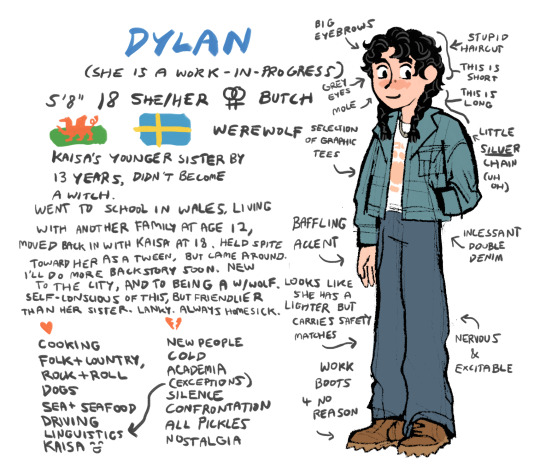

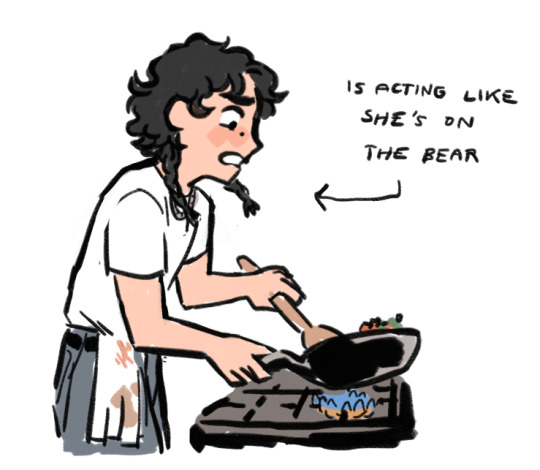


i have to do more bc she isnt rly brought to life yet.. she will change a LOT... but this is dylan :-] (hammarlund? underhill?) i couldn't not do a hilda oc and i couldnt not make it a nervous werewolf. she stresses herself out but is surprisingly organised about cooking, one of the famously stressful activities. she spends a full day planning out a meal, cooking for herself and kaisa (thank god. that nerd cannot cook) and then asks for detailed reviews.
she is very stressed out about being a werewolf though. she has just finished being a teenager and this is kind of that all over again. she does not want ANYONE to find out and confides reluctantly only in kaisa. what she fears is people fearing her, and she feels like the moment her life has been pieced back together again, she's losing grip, again. it's almost a black hound situation when the people of trolberg hear about a werewolf sneaking around. some episode centred around the mystery ensues.
she likes food + music! although she's more of an amateur at music, she owns + plays a guitar, a mandolin, a banjo, and a harmonica. very folksy. she has a swedish-welsh accent. try and imagine it please.
the default sister dynamic is kaisa getting home from work late (she probably lives in a flat in/around the library), and dylan being in the midst of homemade ravioli or something with a sauce that took 6 hours. kaisa asks about her day to be polite. dylan tells her about the sauce that took 6 hours, a long hike, 3 different invasive plant species, a lot of butter, and the use of powertools. kaisa has been re-shelving niche history of magic books but got so caught up re-reading them that it also took up 6 hours. when they have eaten dylan asks for her opinion and scribes the whole thing down in her notebook as kaisa voices her 5 star yelp review. they do not ask anything else about each others days and interact mainly through dylan slow-motion fake-punching kaisa while she is trying to just hang out in the living room or do her work and is ignored. only when she is in a very good mood will kaisa fake-punch back. dylan has a lethal case of younger-sister-that-is-taller syndrome.
sorry for my handwriting but the vague outline of her backstory WHICH MAY PROBABLY CHANGE is:
from the time she was 8 and kaisa was 21, they lived alone together. kaisa became a full-fledged witch between then and age 25, when suspicion against witches was on the rise for a short while - dylan never became a witch, but the only trusted adults in her life (basically kaisa and tildy) were, and they decided it would be best for her to grow up somewhere less troublesome. they were both pretty messed up about her having to move away, dylan holding some kind of spite toward her sister for a while, and kaisa feeling incapable, guilty and ill-equipped to take care of her.
she went to school in wales at 12, living with as-yet-unspecified family members/friends, and while kaisa almost immediately regretted sending her away, dylan adjusted quickly and spent the rest of her school career there. after a few years she forgave kaisa, because she ultimately enjoys her life, but she is stilll missed at home. at 17 going on 18 she became a werewolf (whether she was bitten or it was always in her somewhere?) and four months later she finished sixth form and called kaisa out of the blue asking if she could come and move in. since they didn't live in trolberg before, she's new to the city.
i will write more cohesively about her relationships to other characters/flesh her out more later, ESPECIALLY the werewolf stuff, but now i have to go to bed. thank you for reading :-] feel free to ask/suggest anything about her!! i love discussing hilda ocs
by the way this is i think my first ever actual OC? i've made up others before but they've just been single designs i've never really thought much about their actual selves because i suck at writing. dylan is the first one thats really stuck. part of her is based off myself and people i know, most of her is not. the main similarity between us is double-denim.
this is fun though. critique is welcome
(obviously her werewolf self is a swedish elkhound. i know the design kind of just looks like a furry im working on it)

#hilda the series#hilda netflix#kaisa#dylan#hilda oc#original character#im going to bed sorry this is not proofread
131 notes
·
View notes